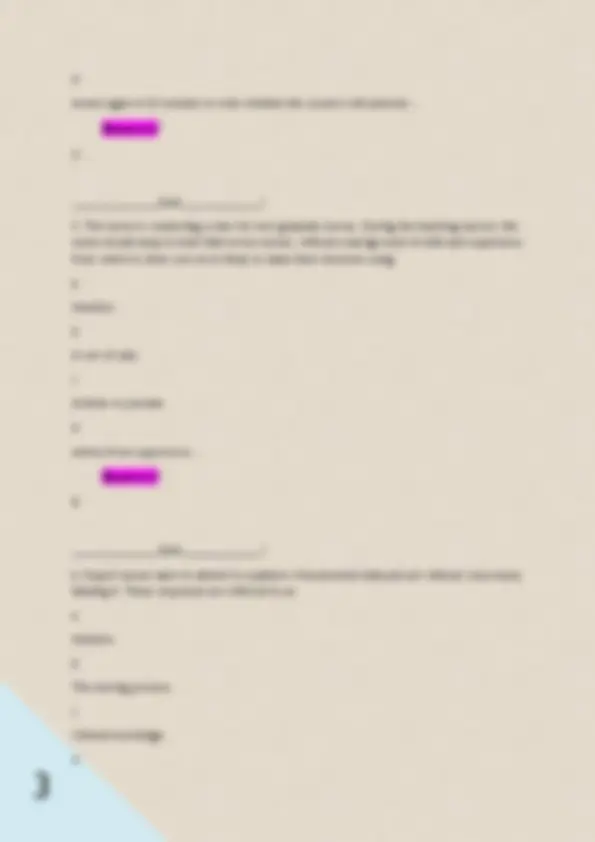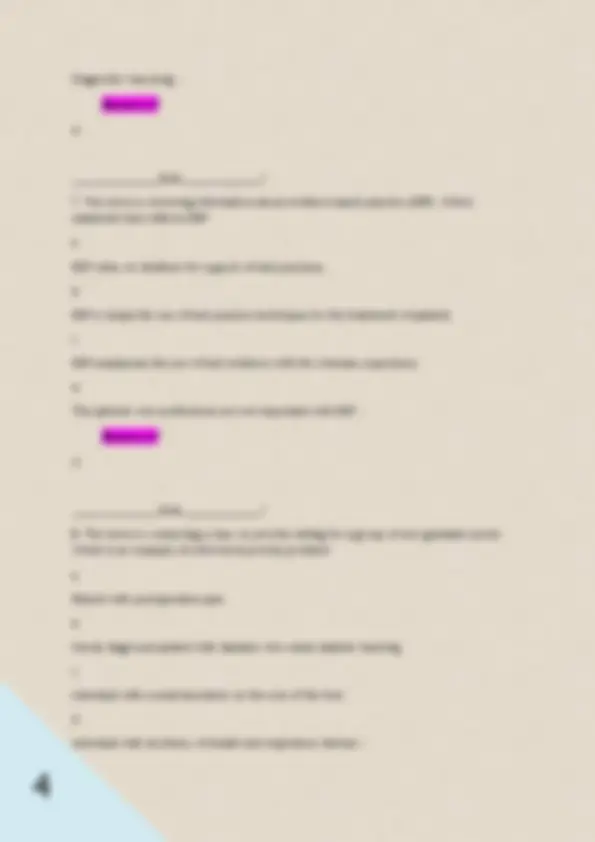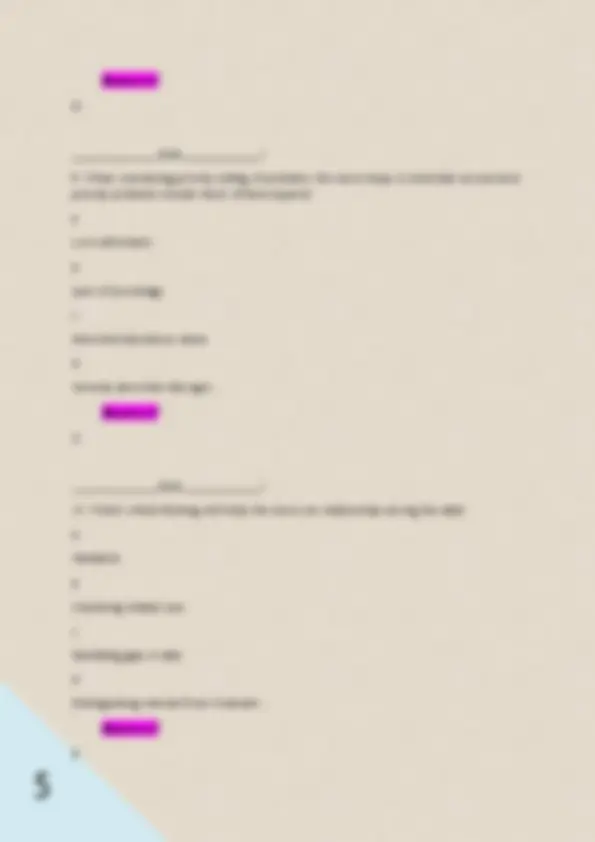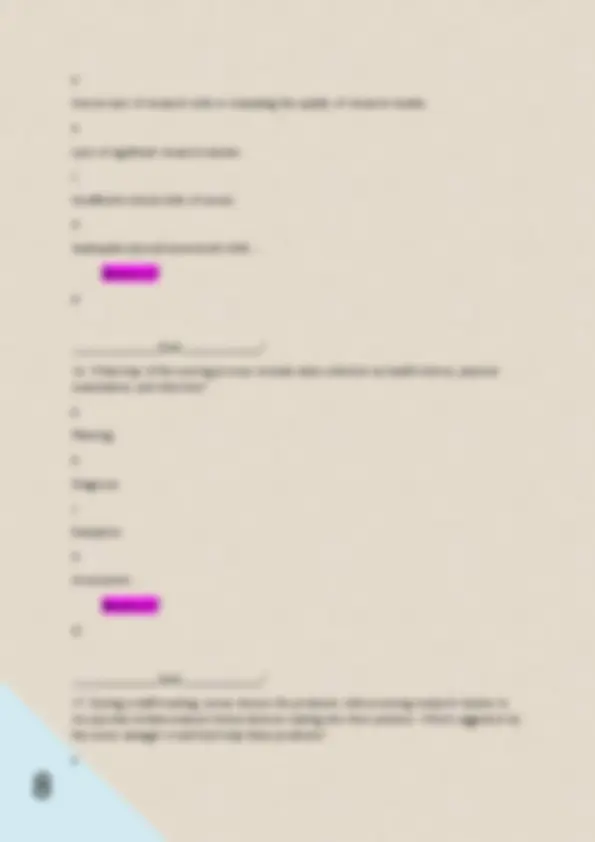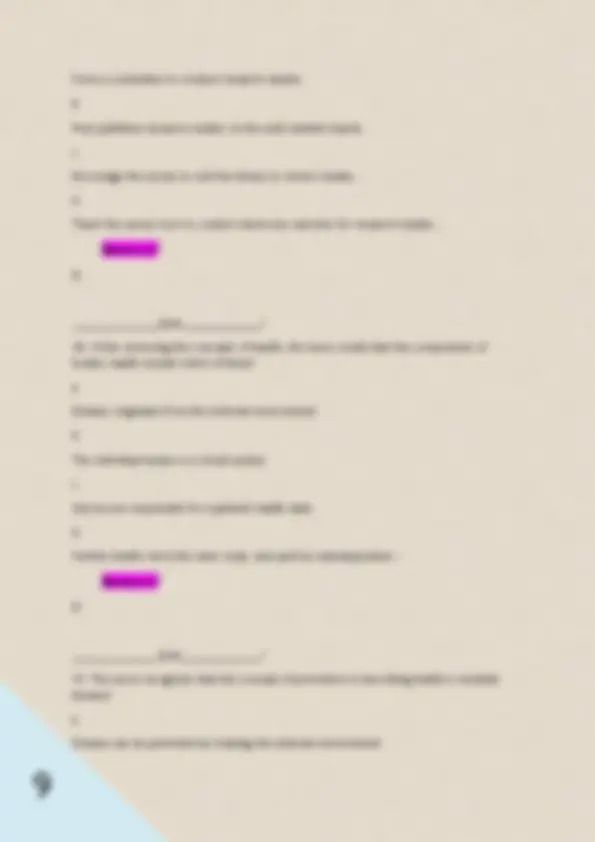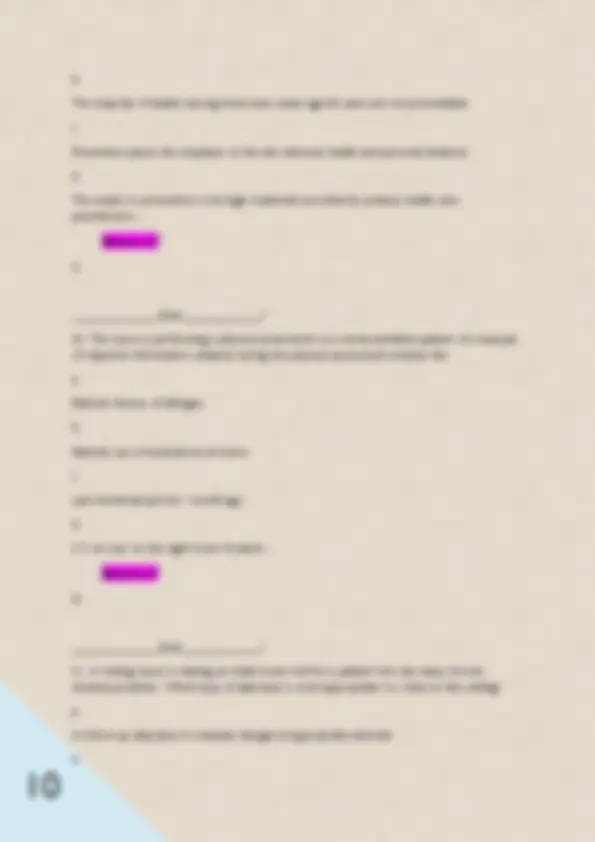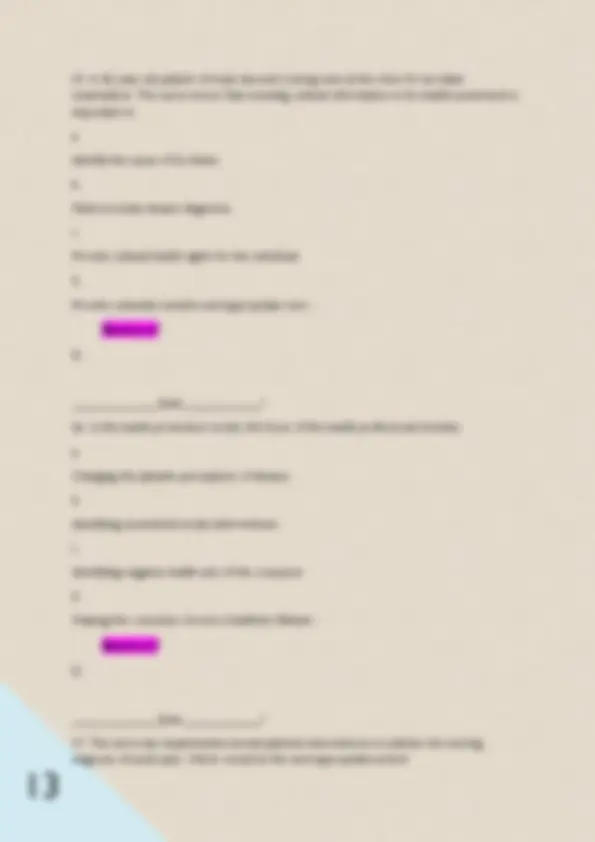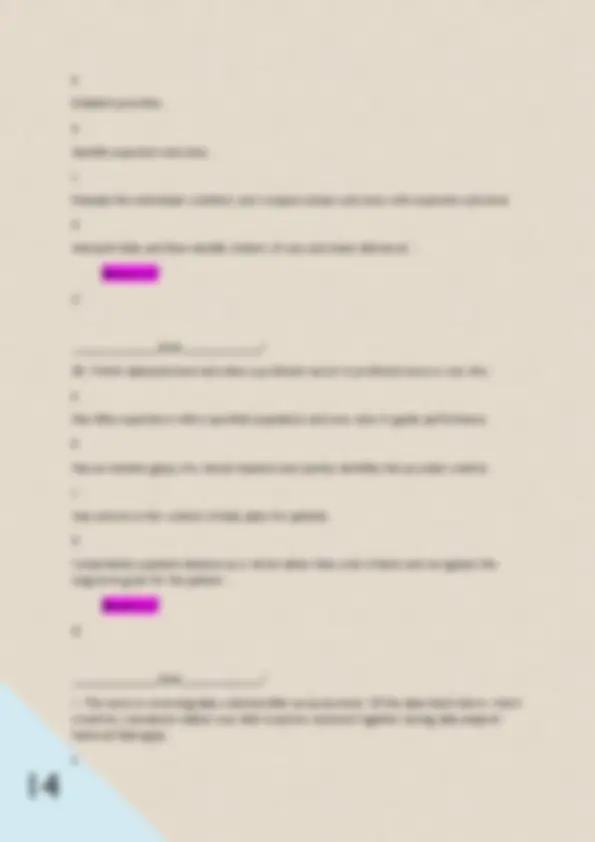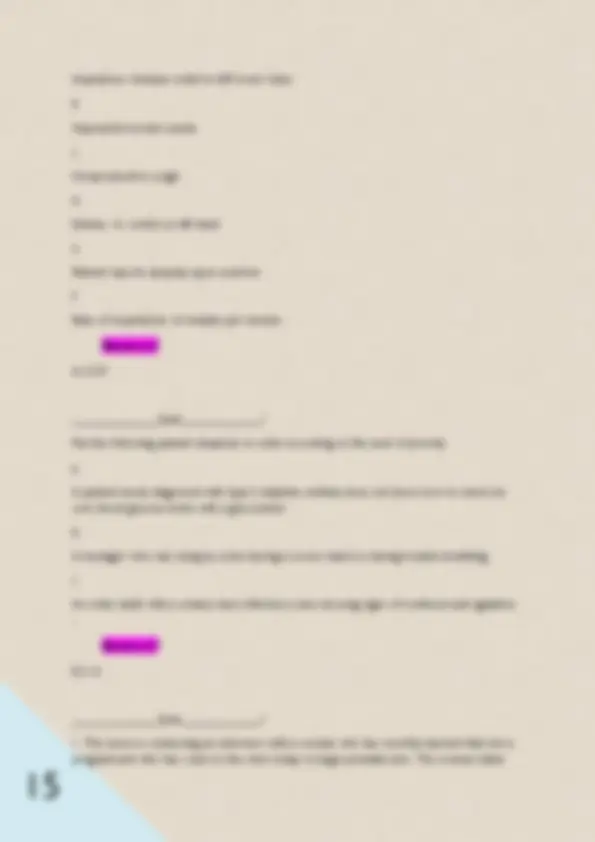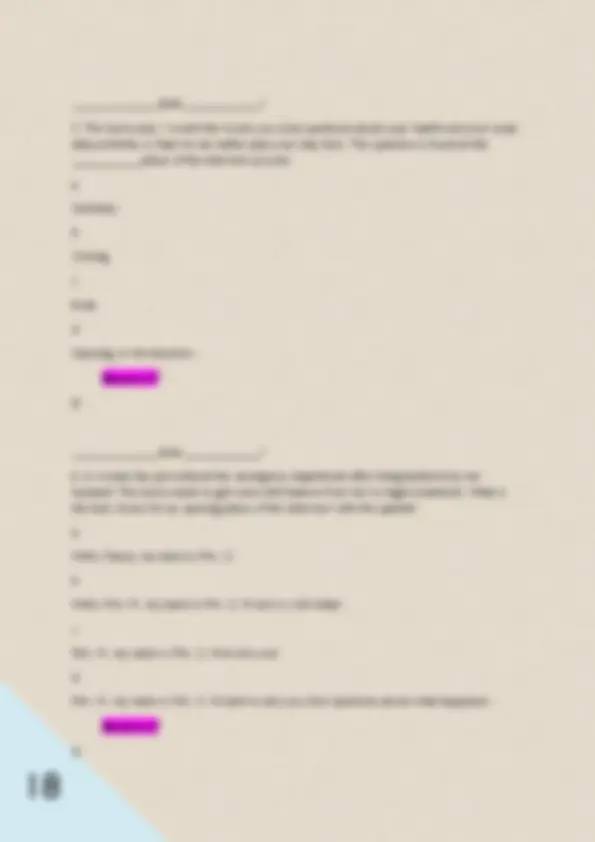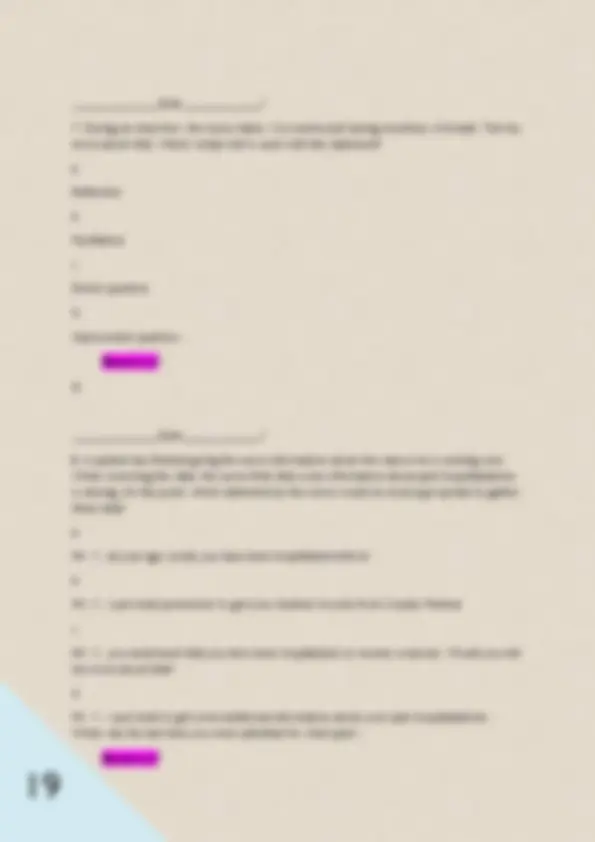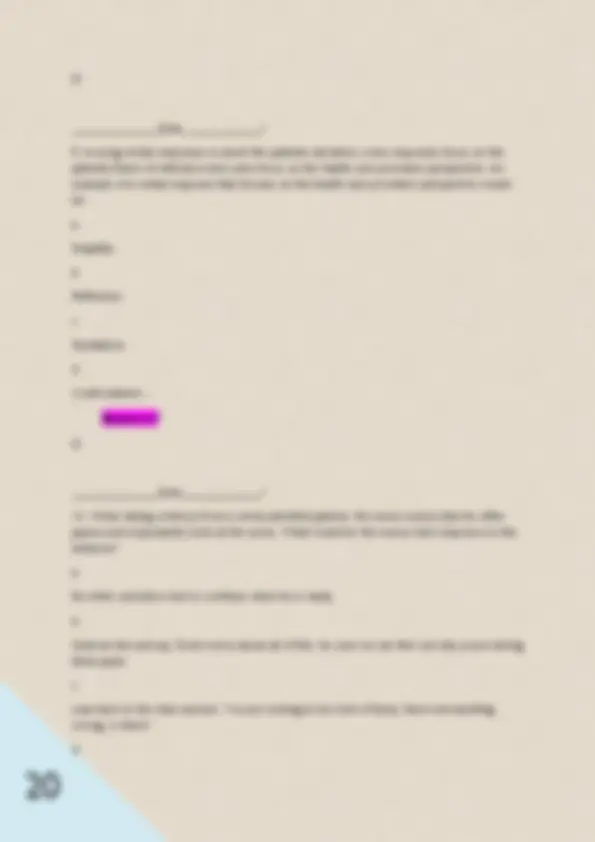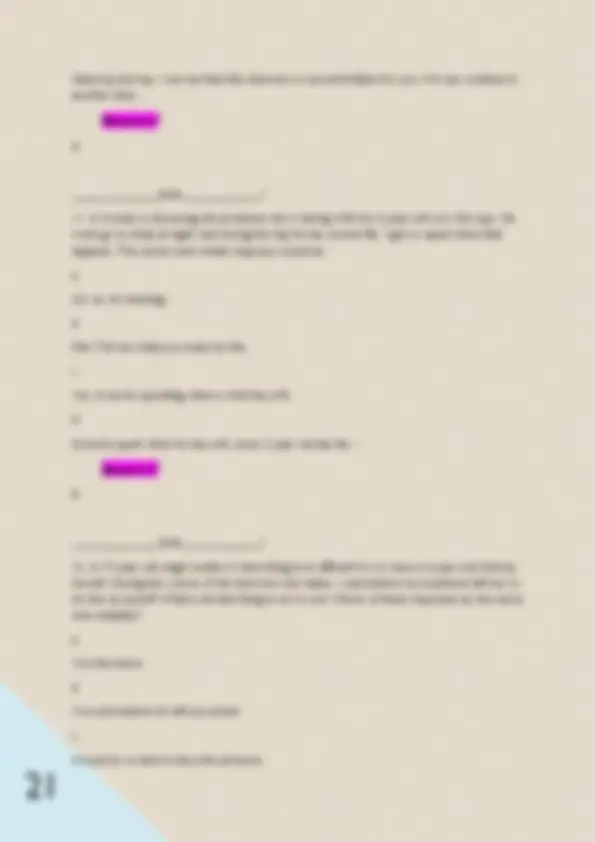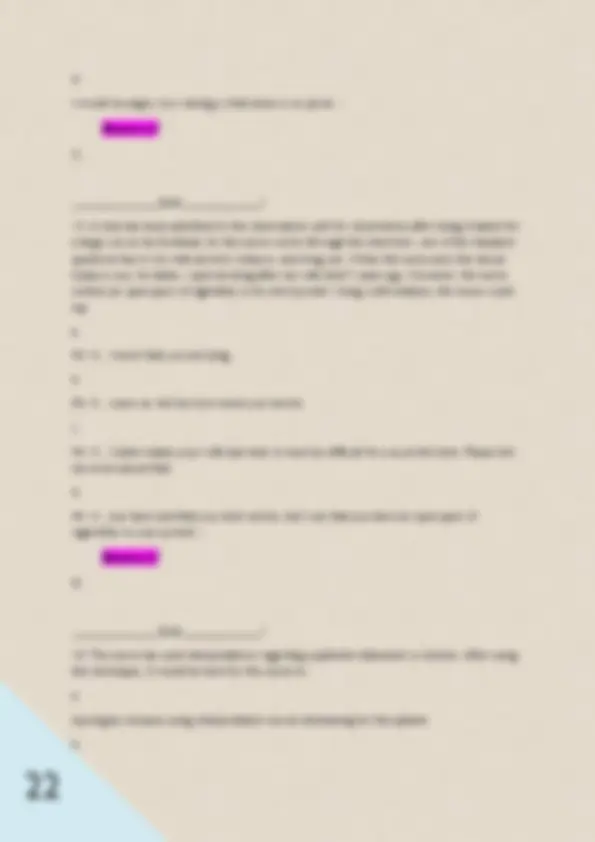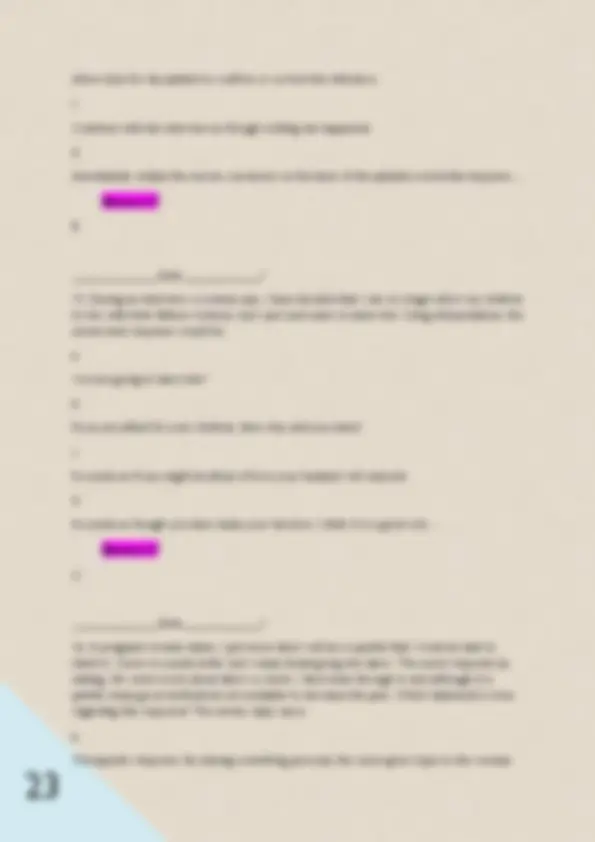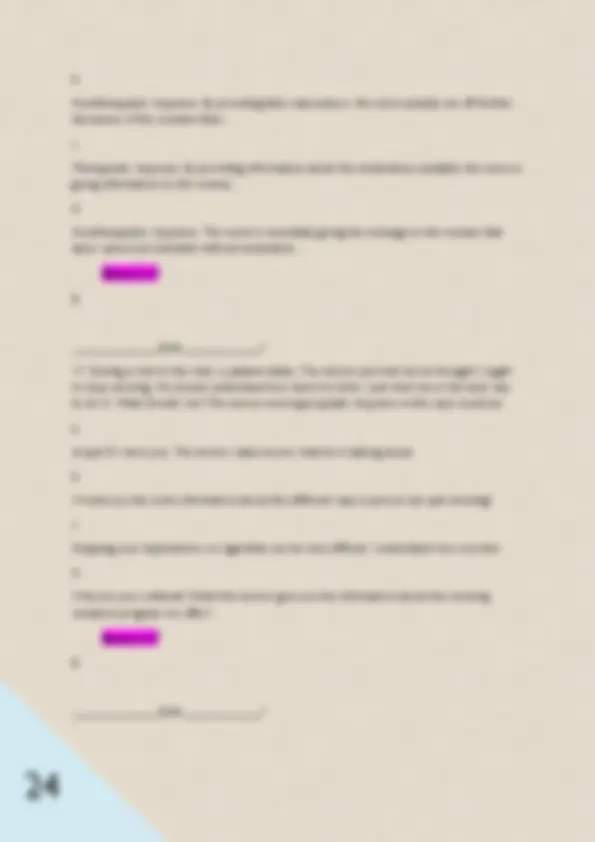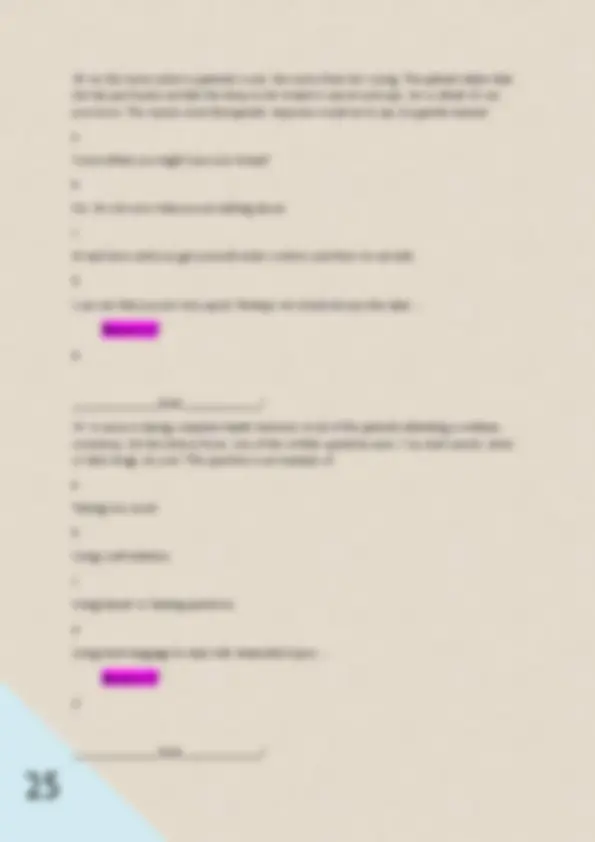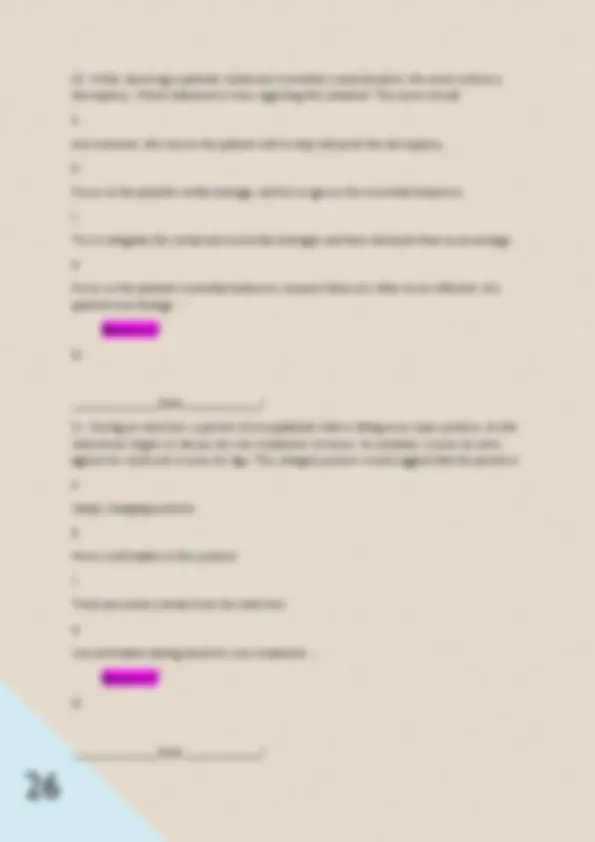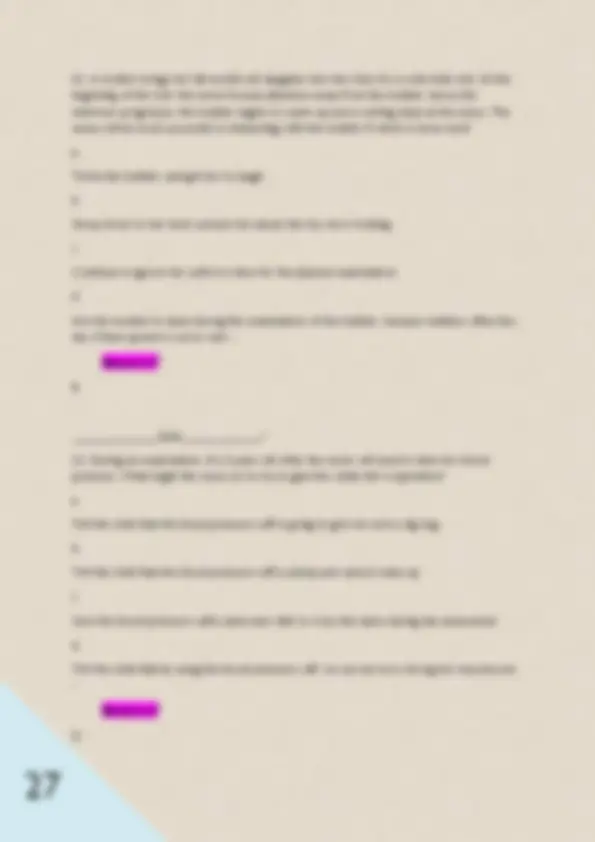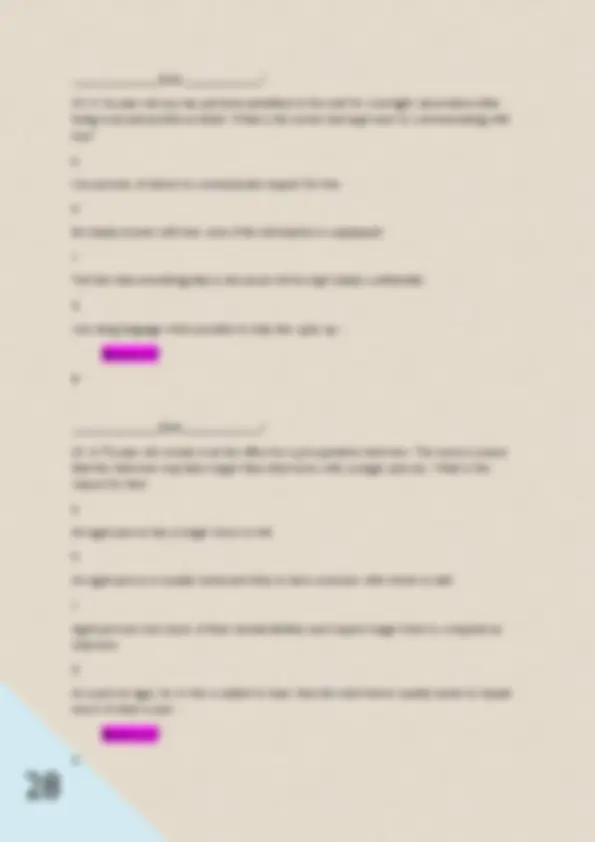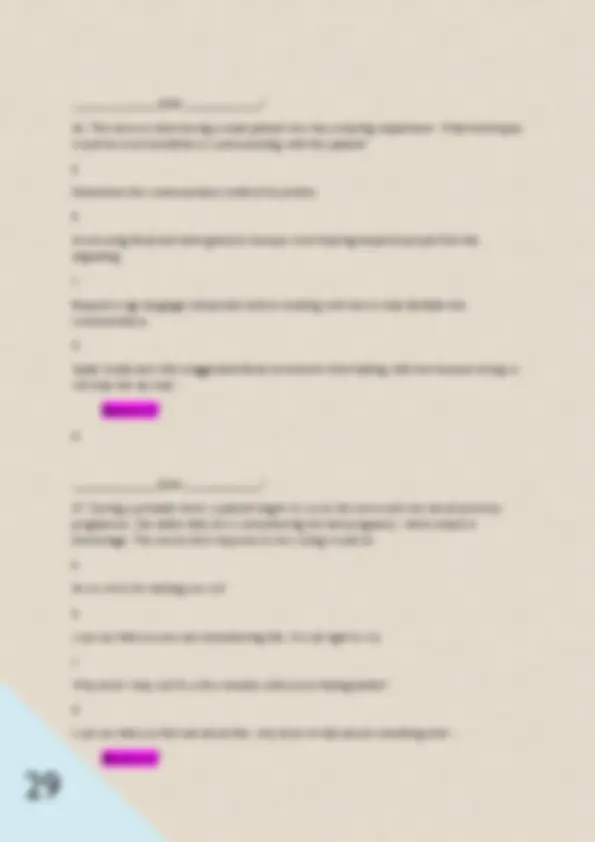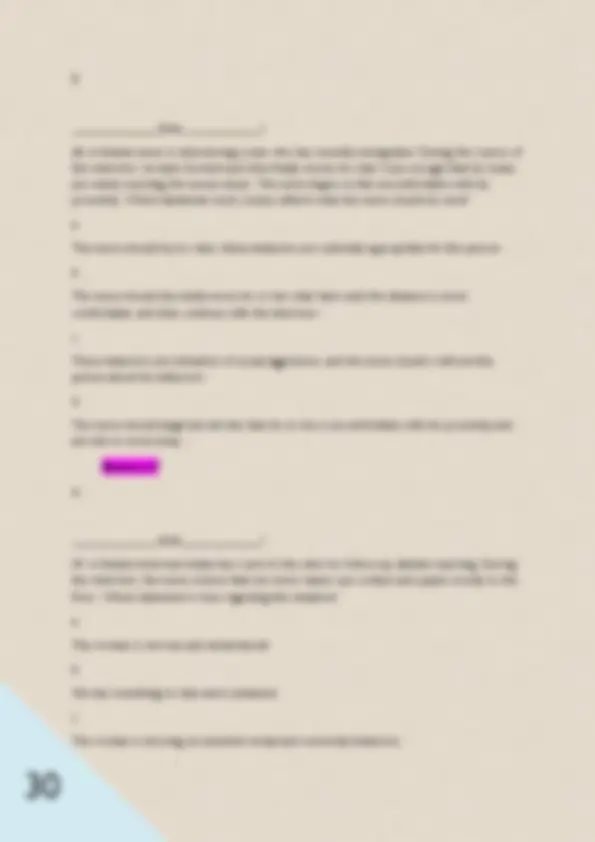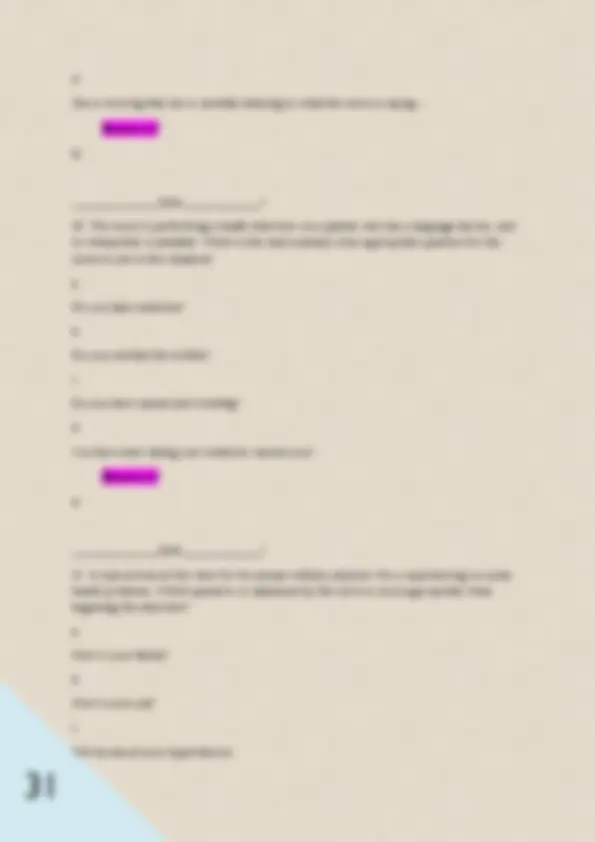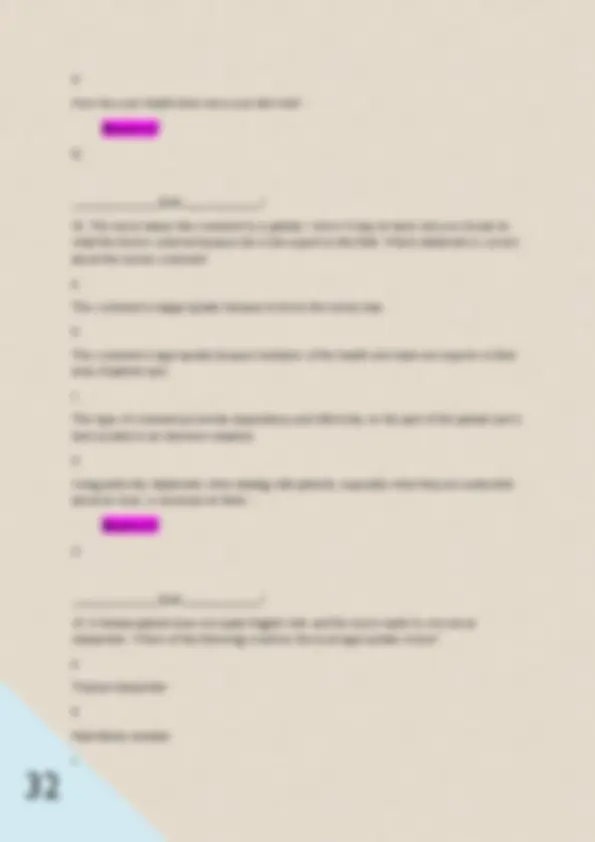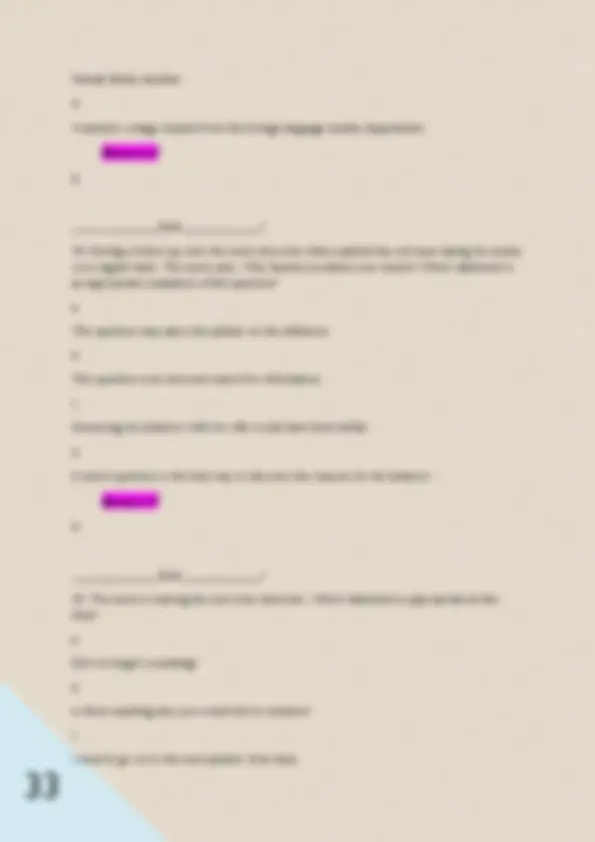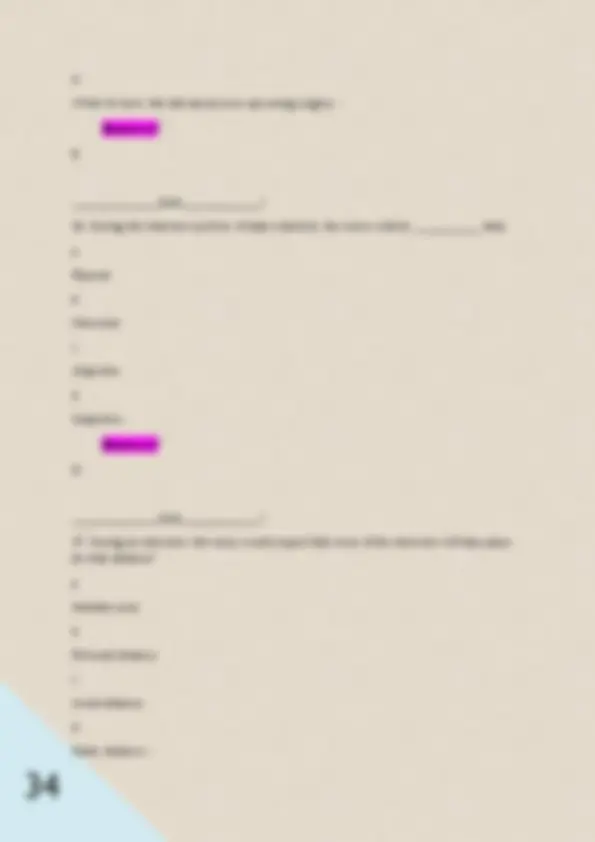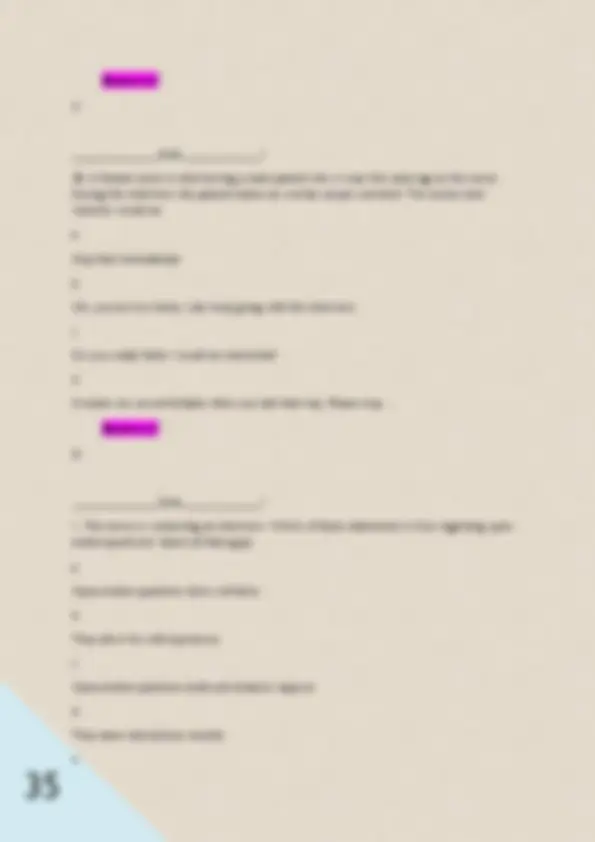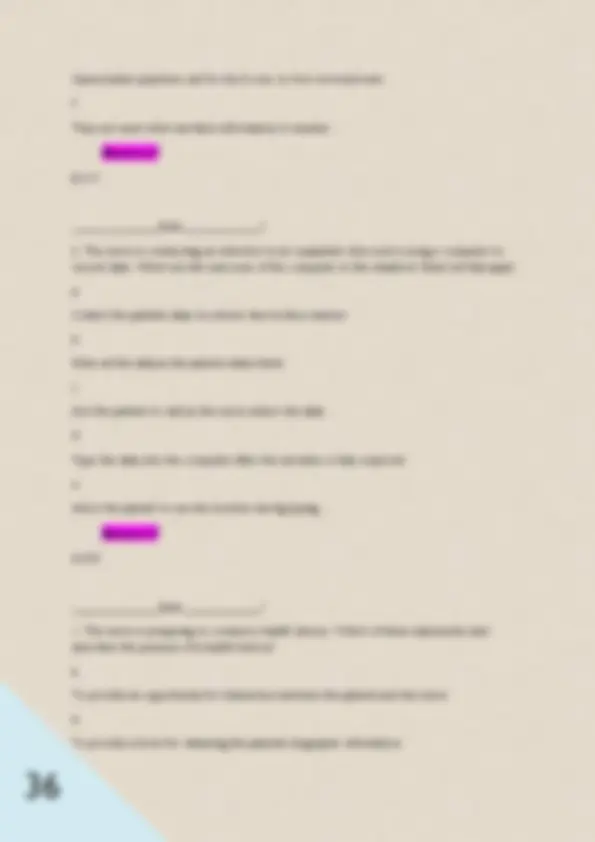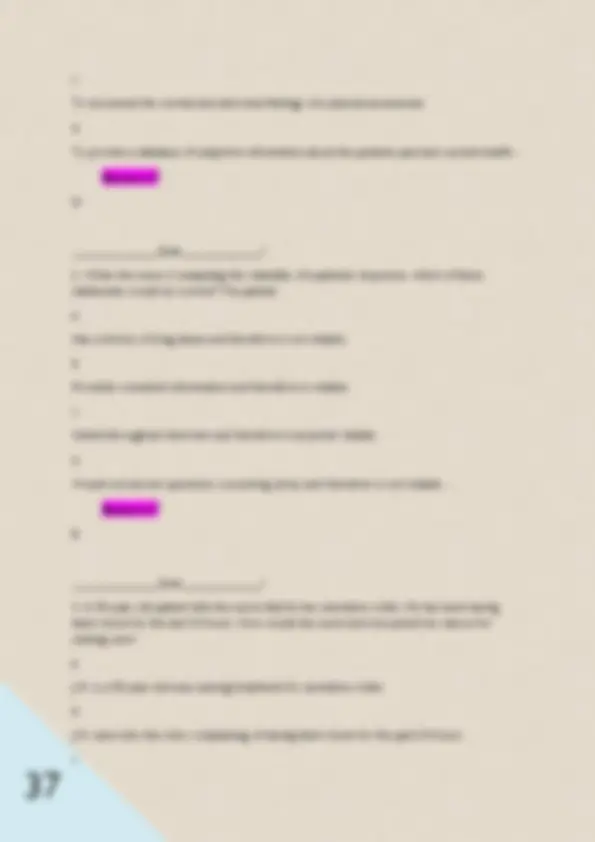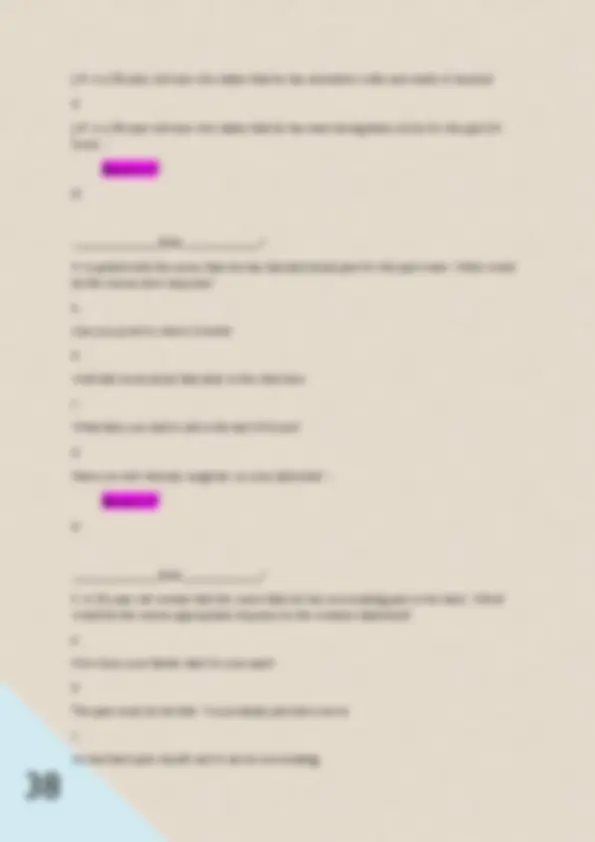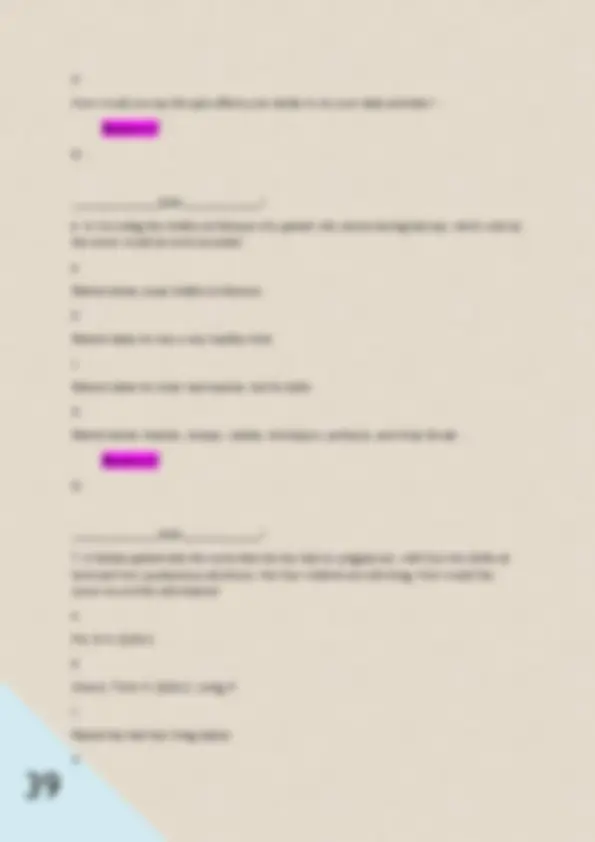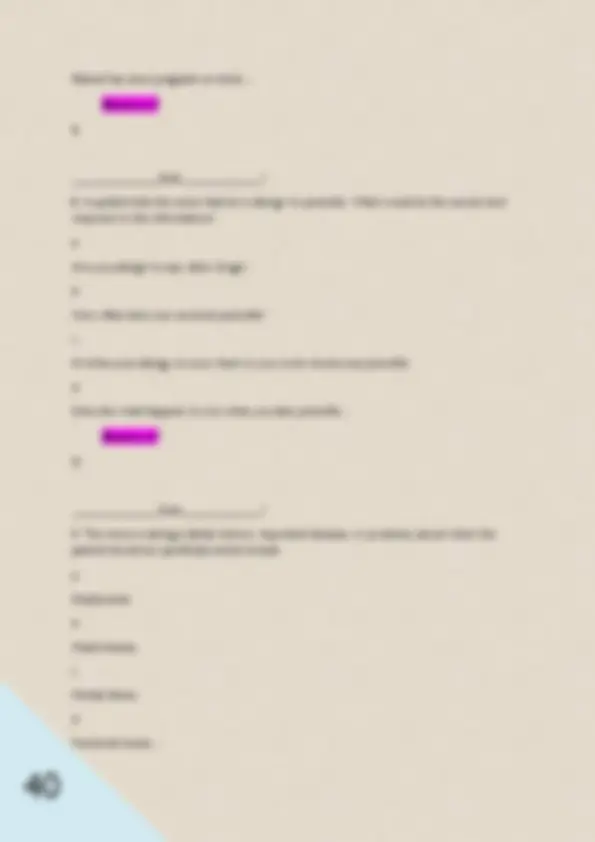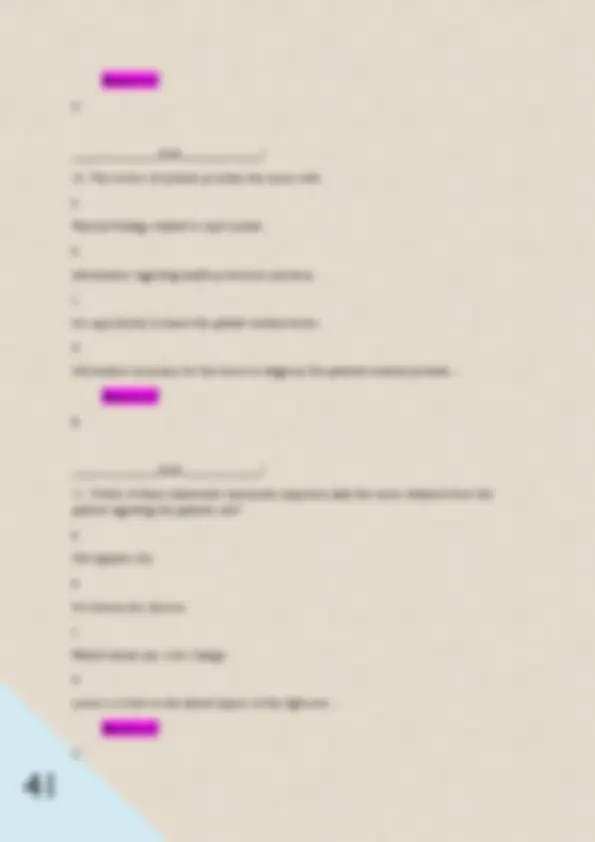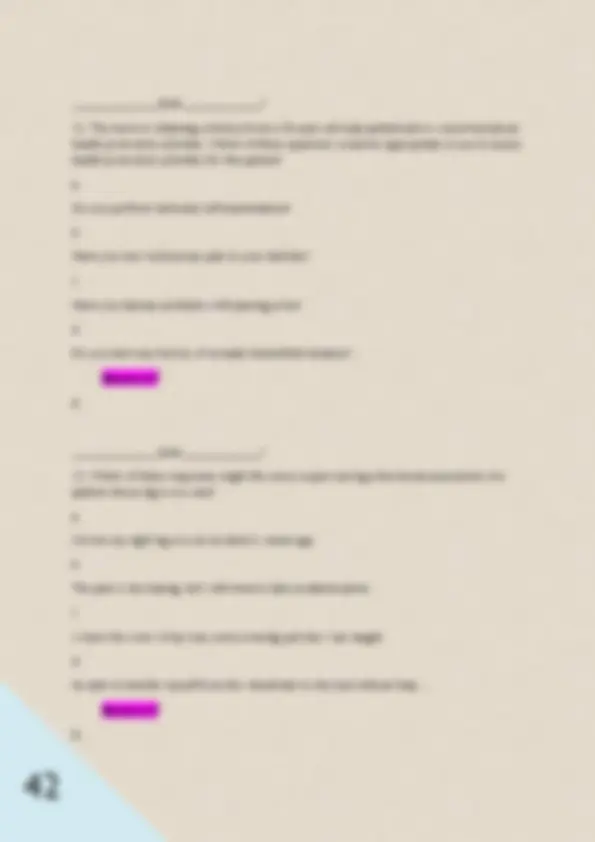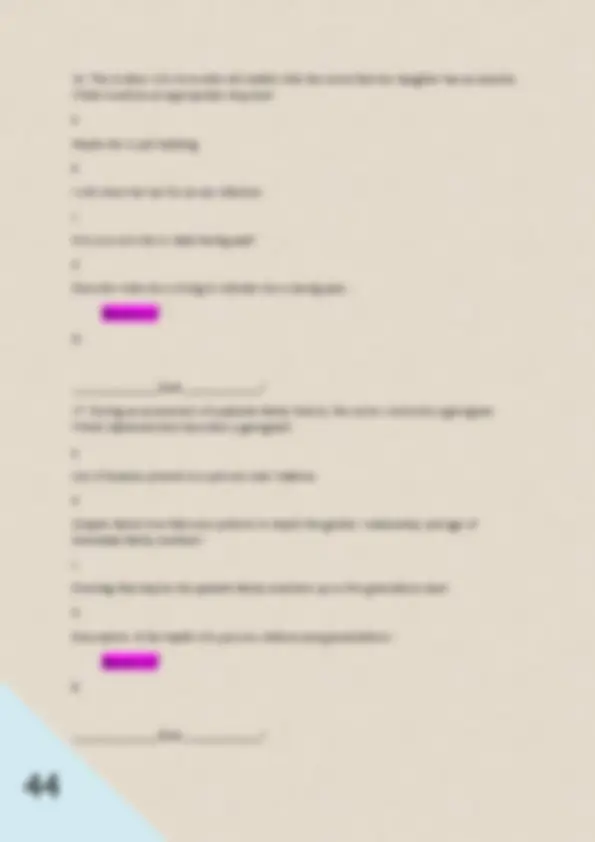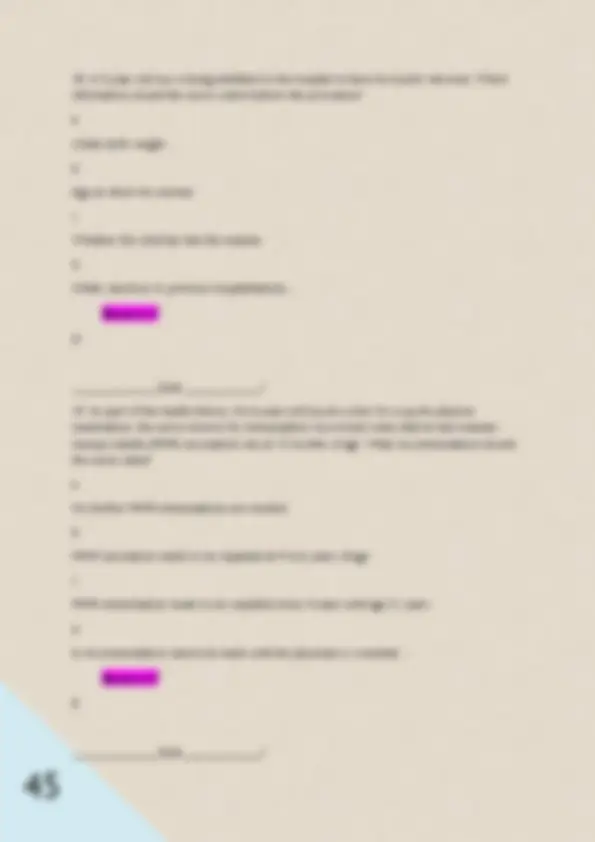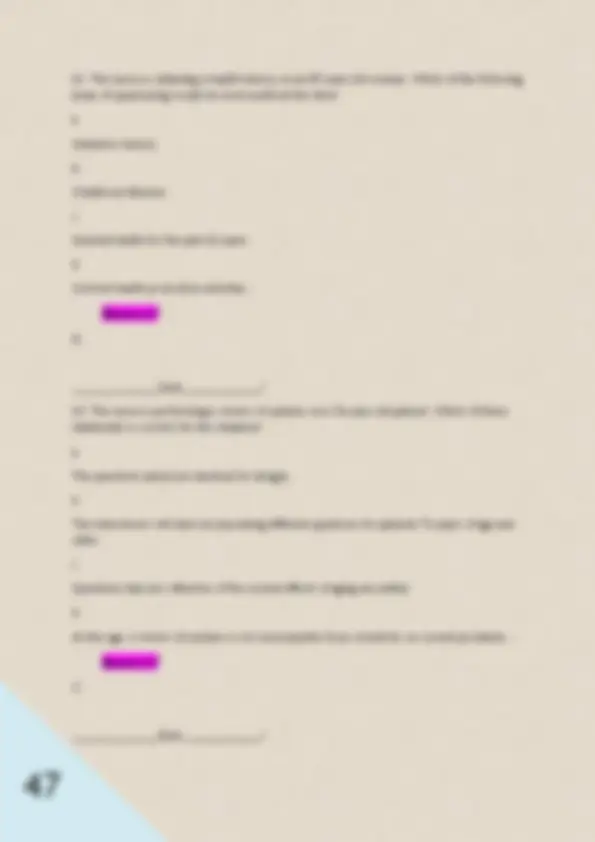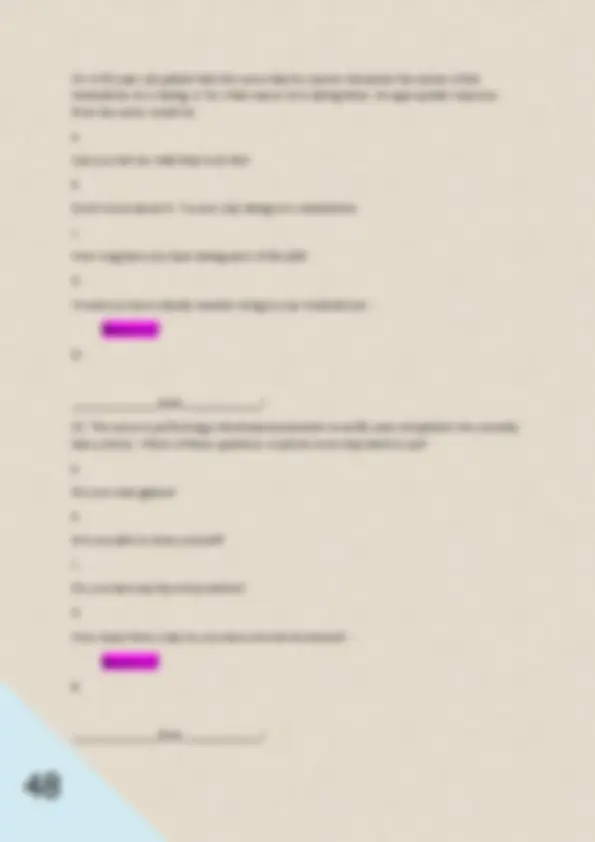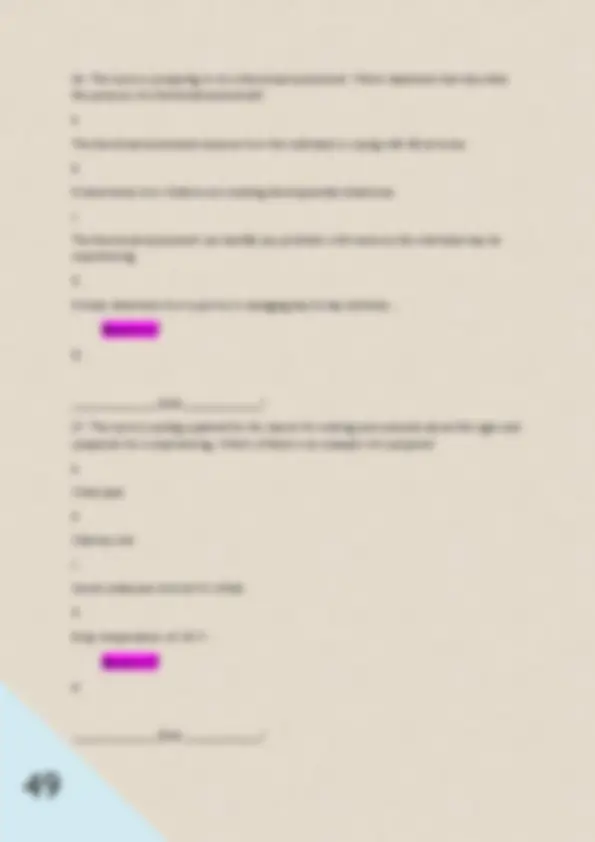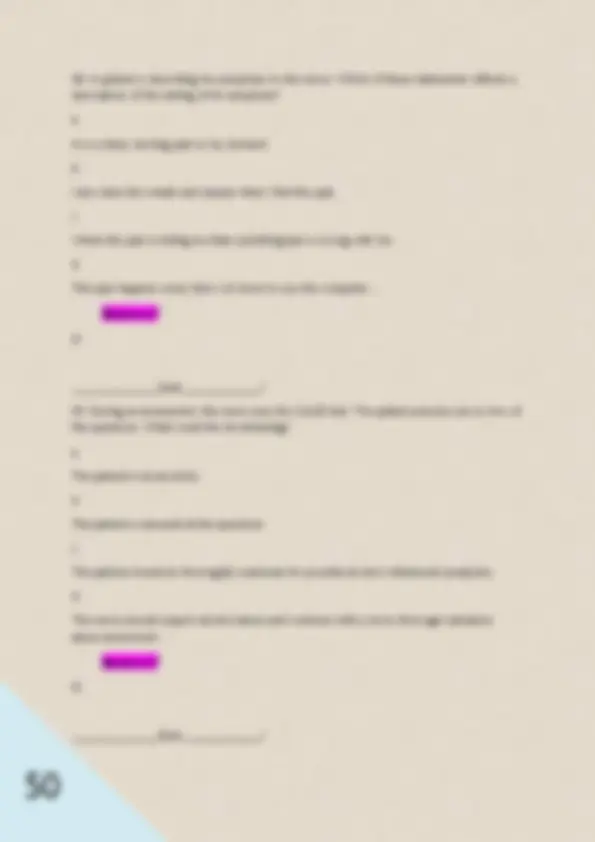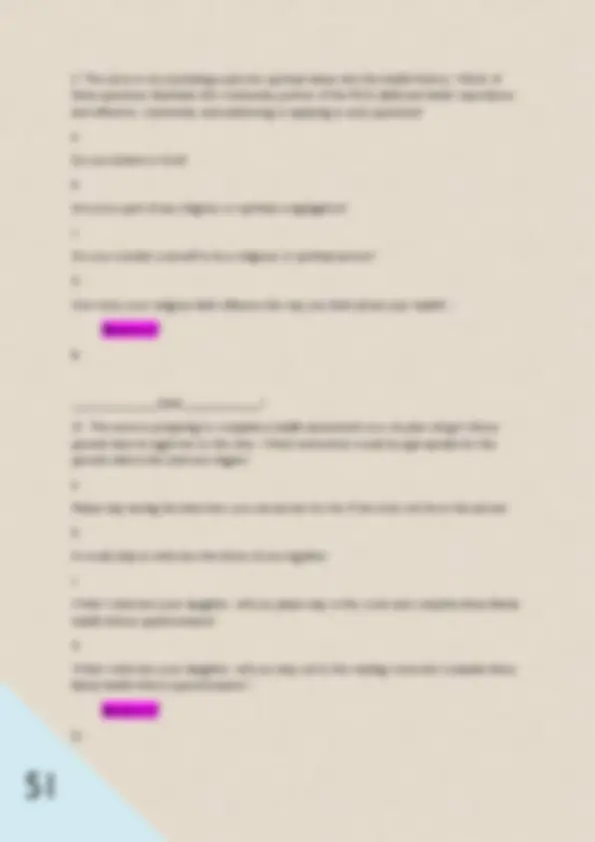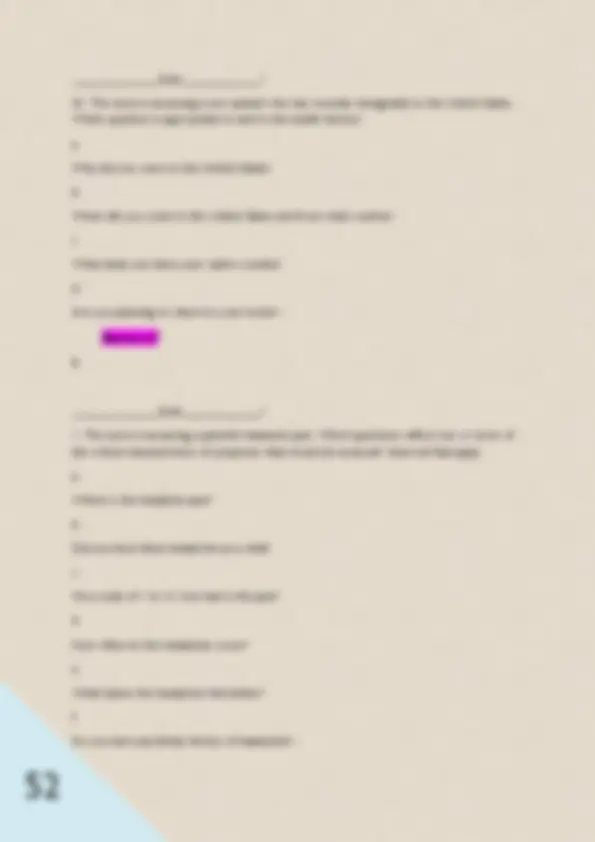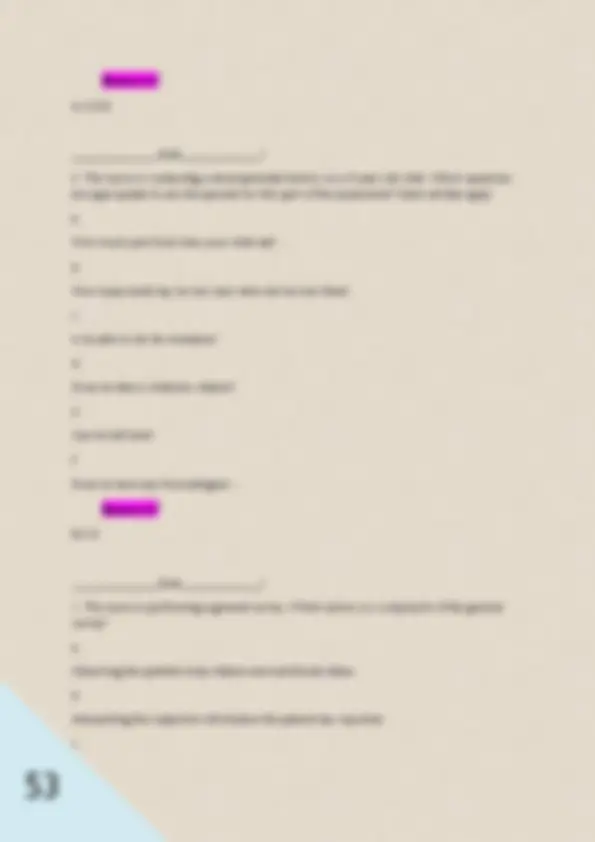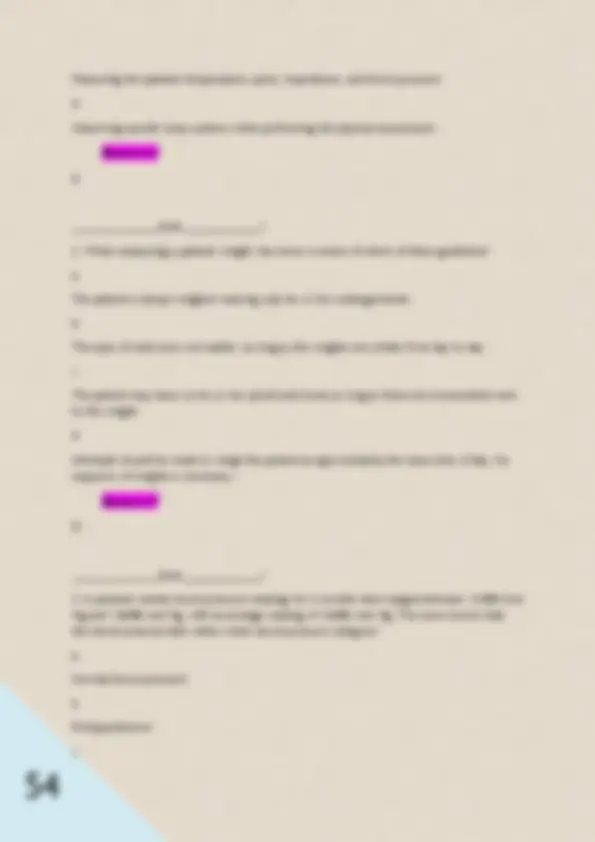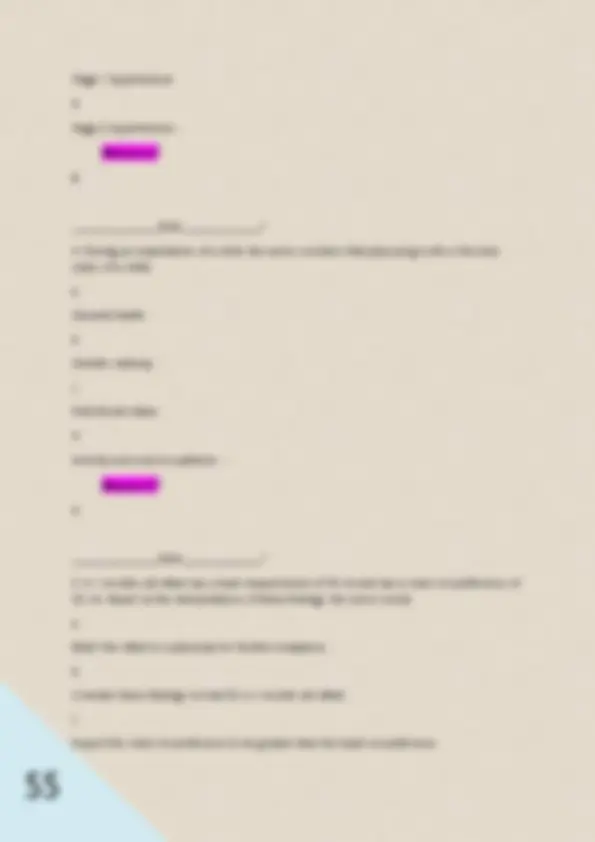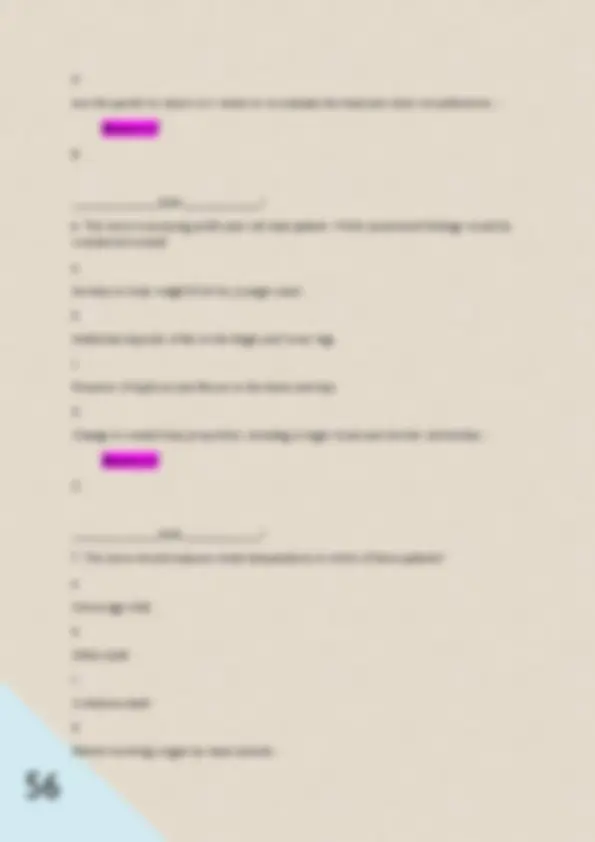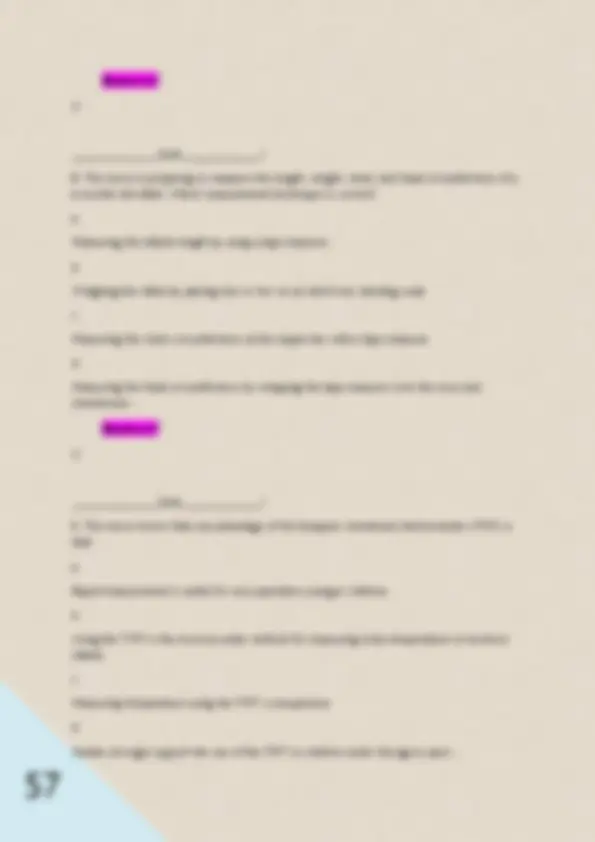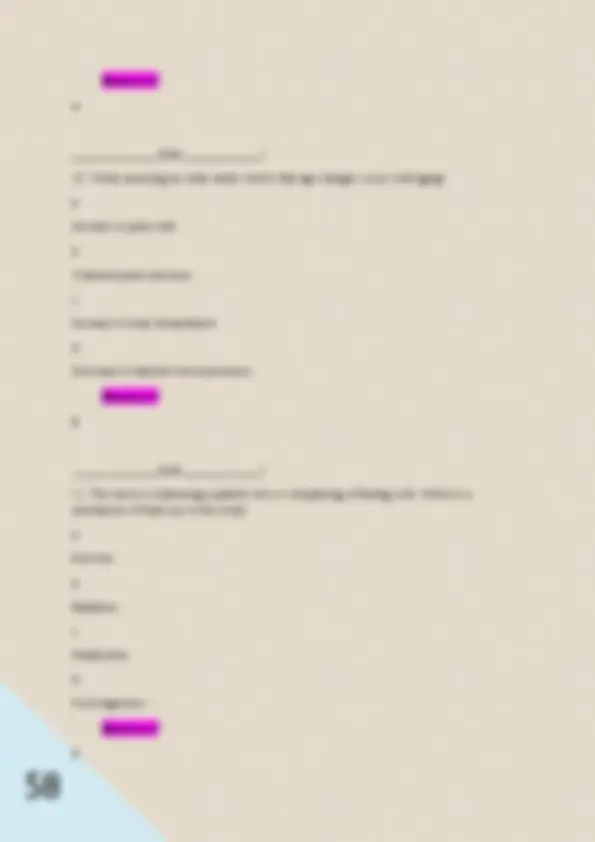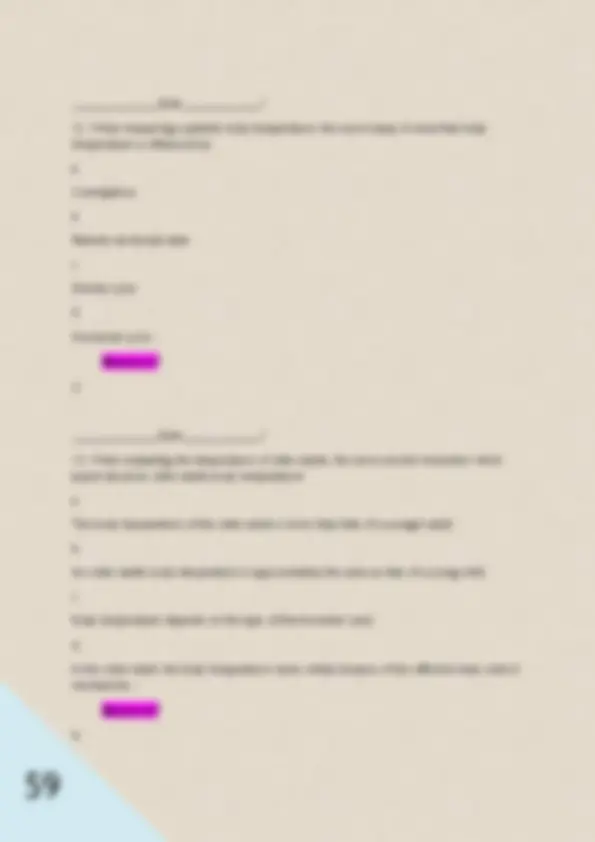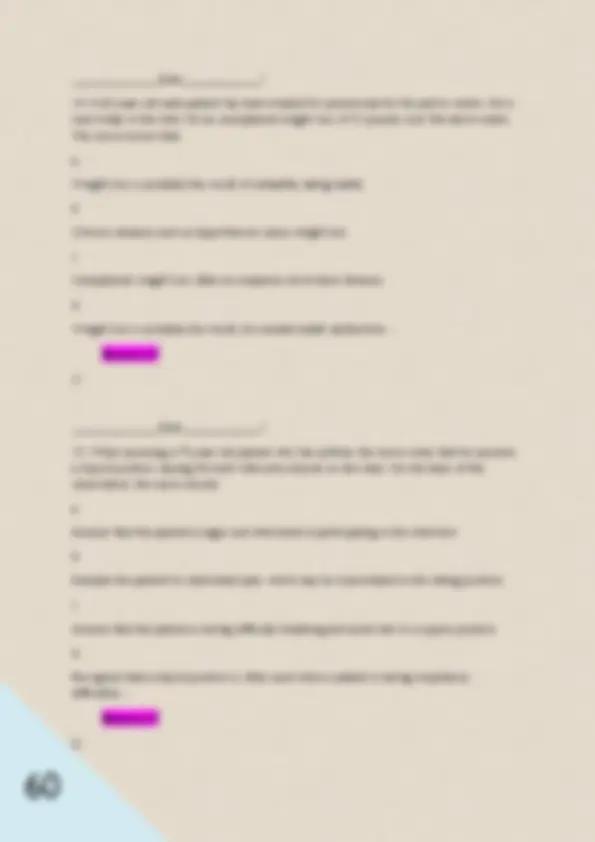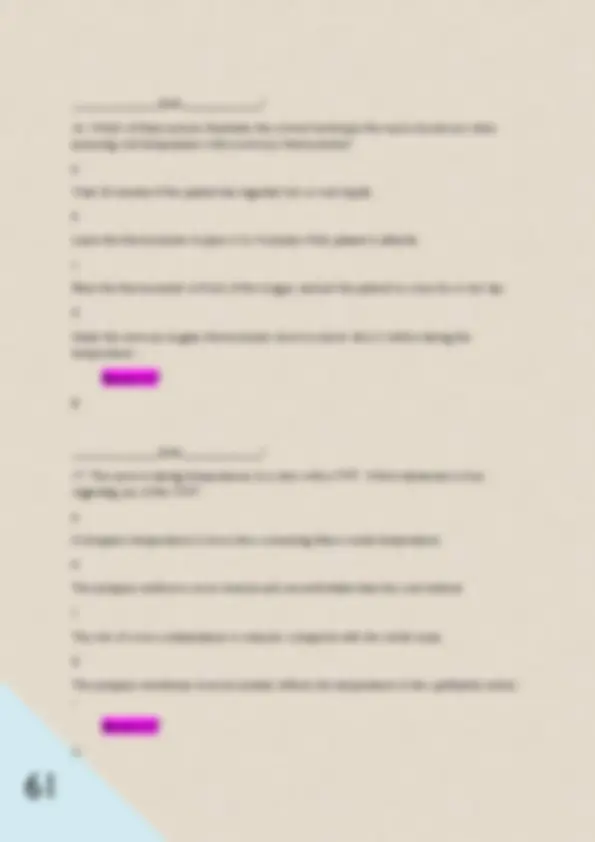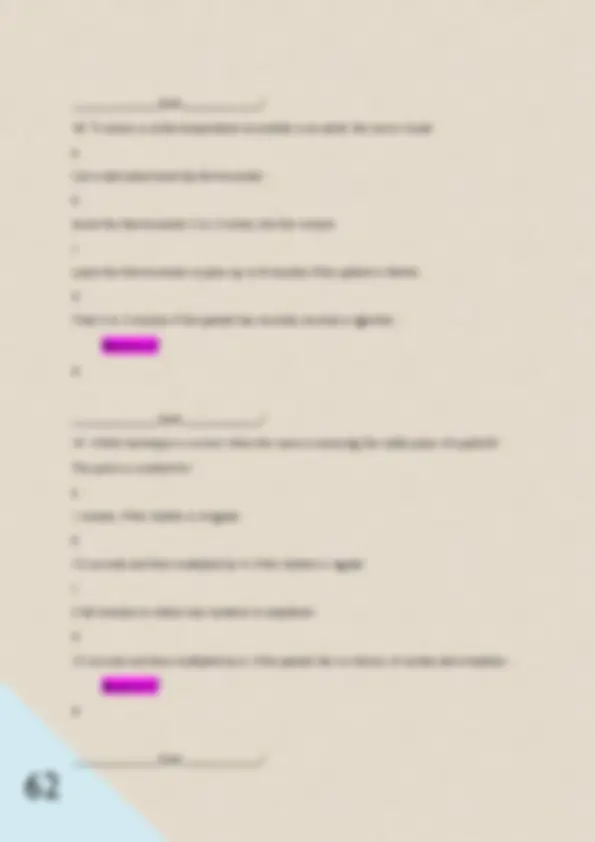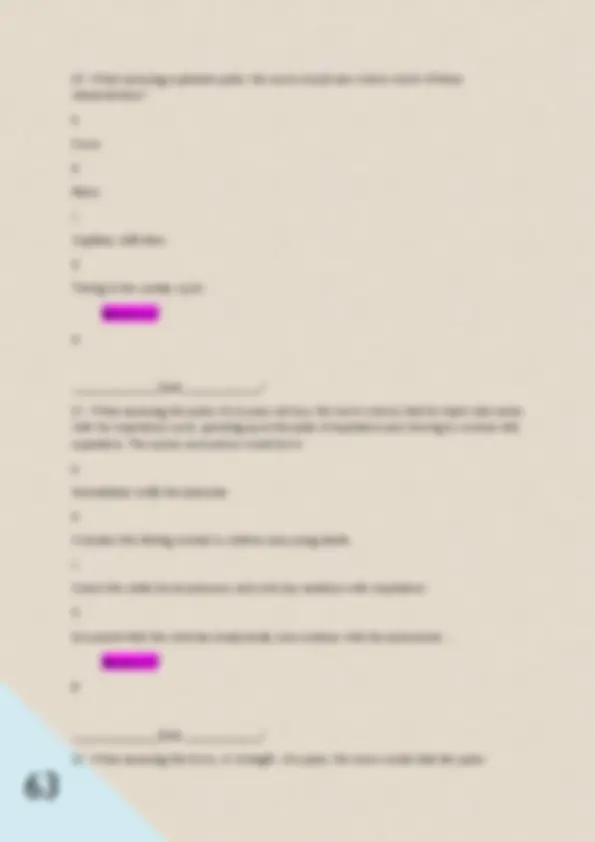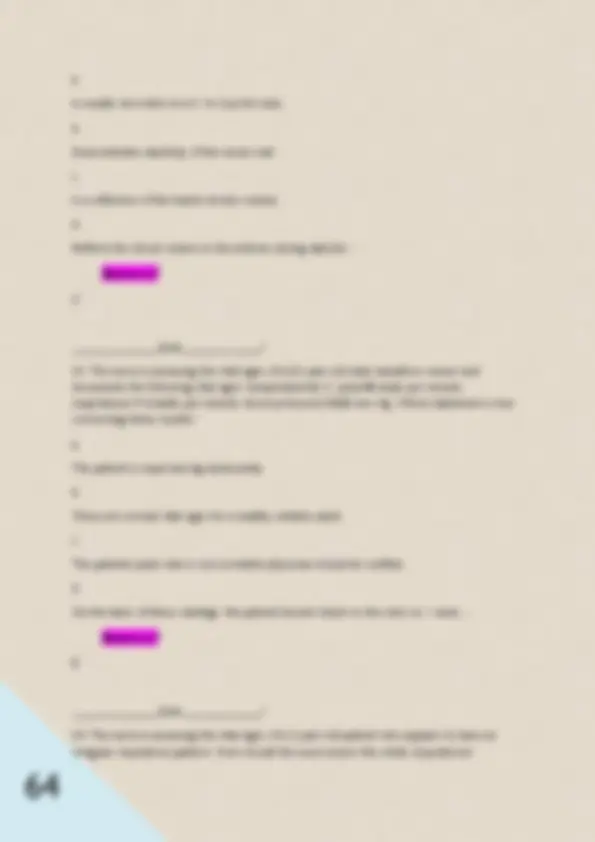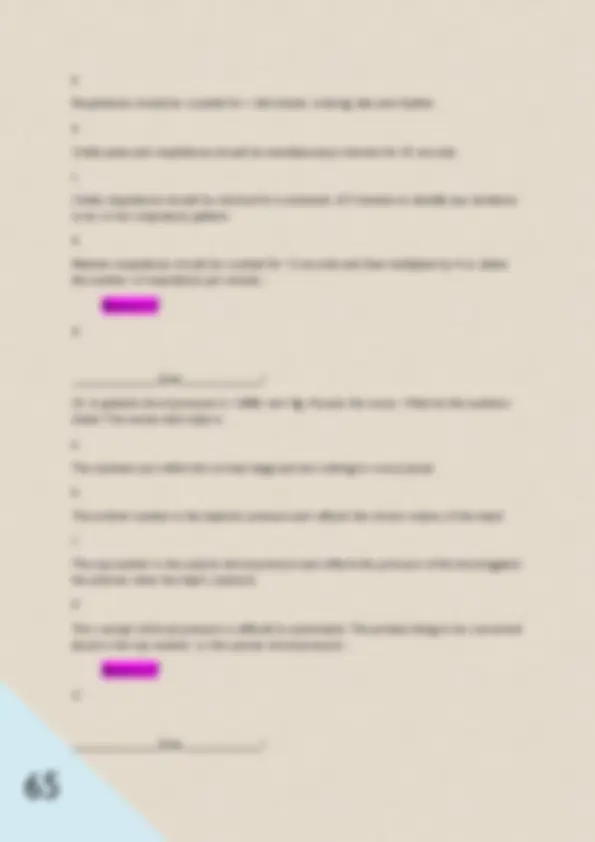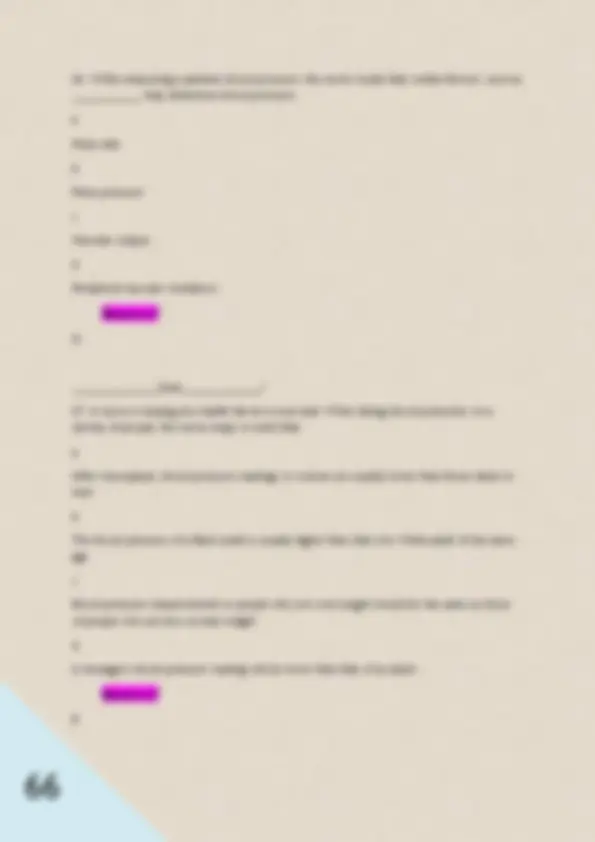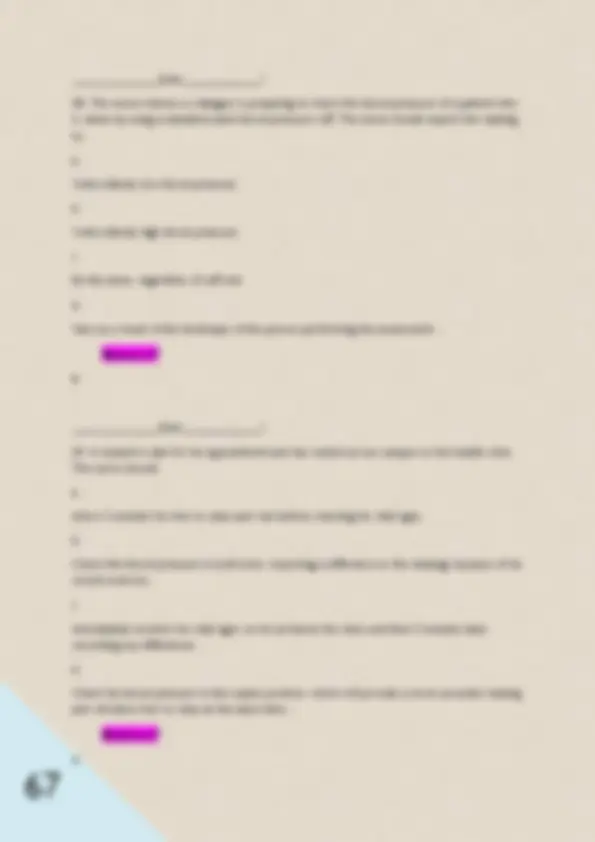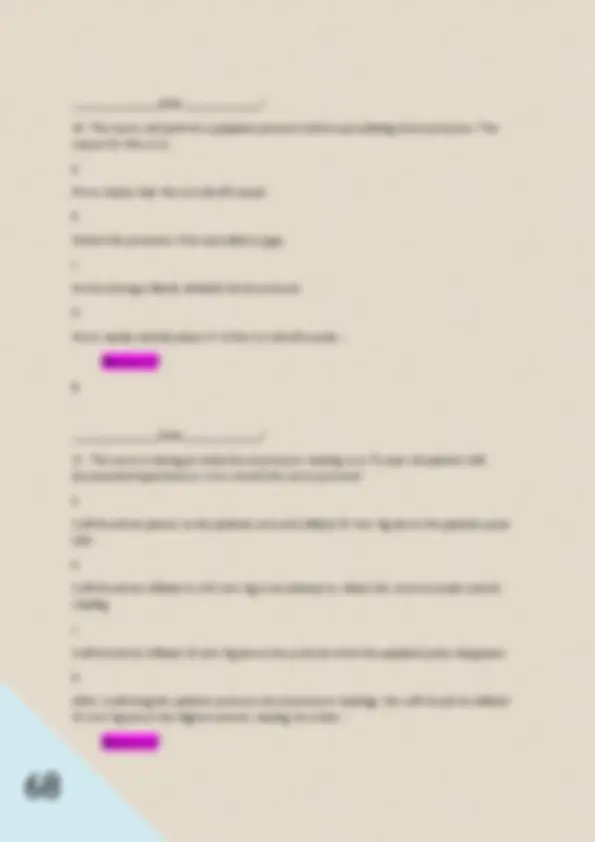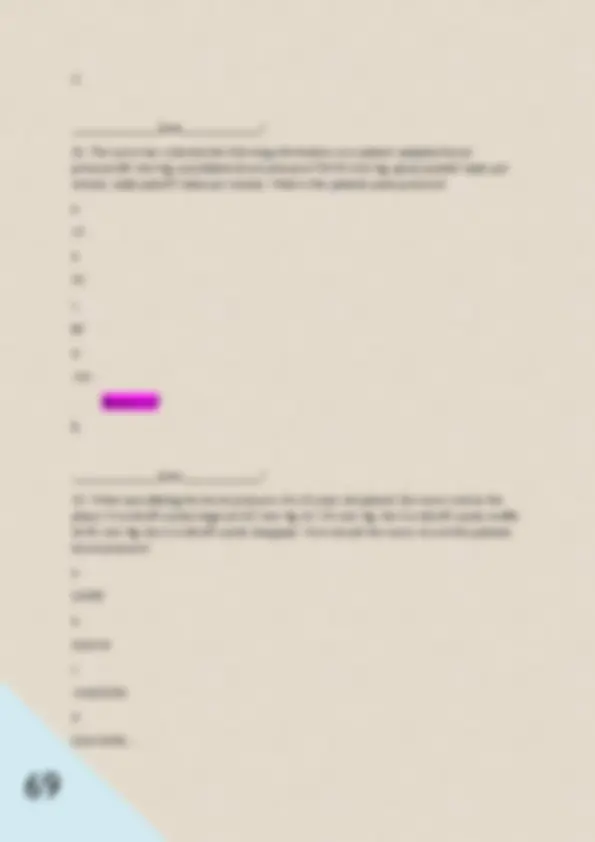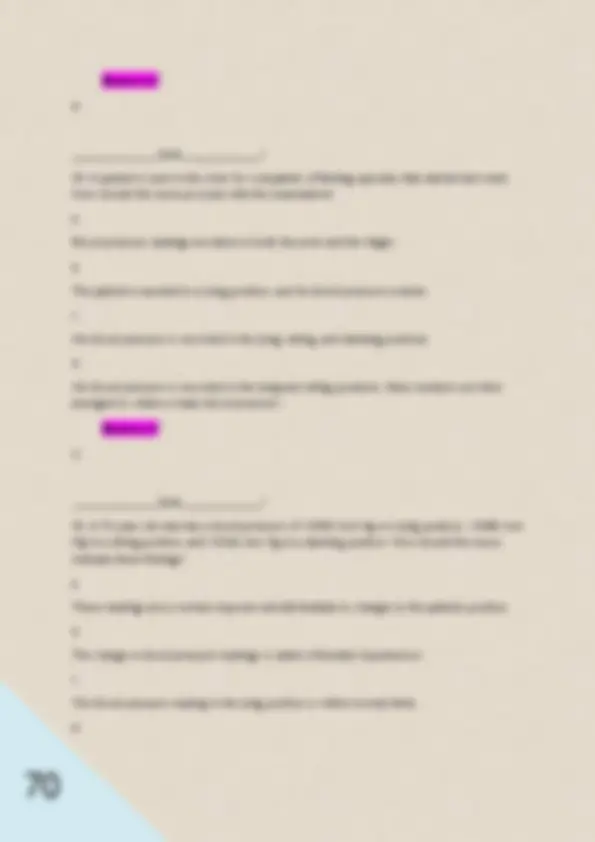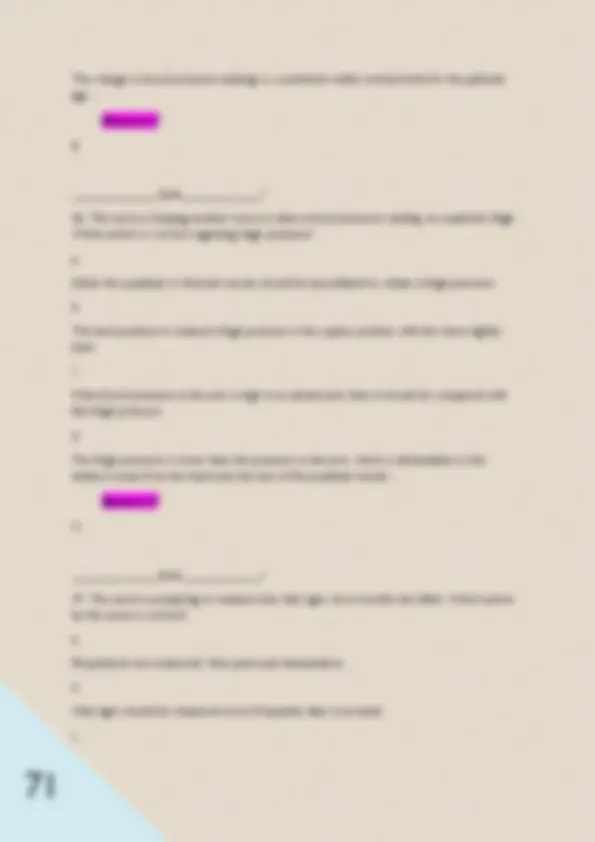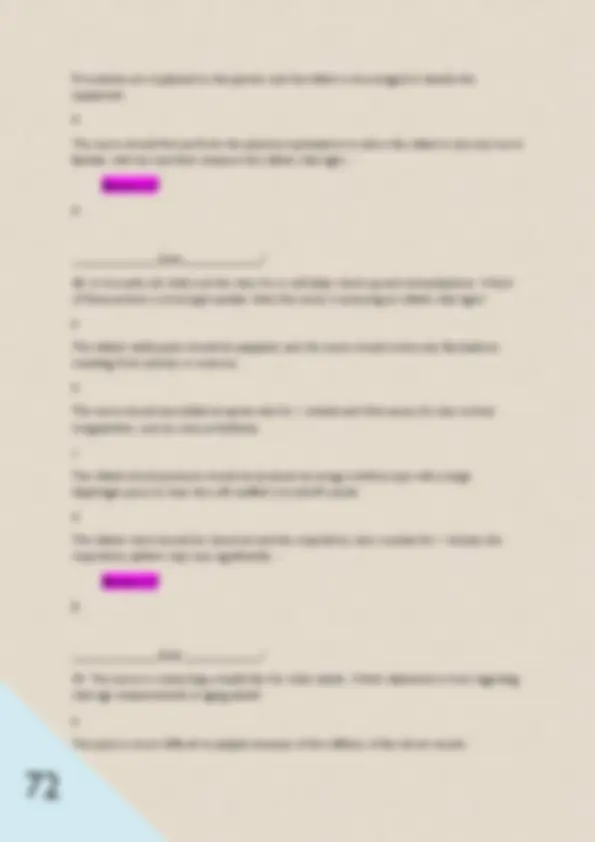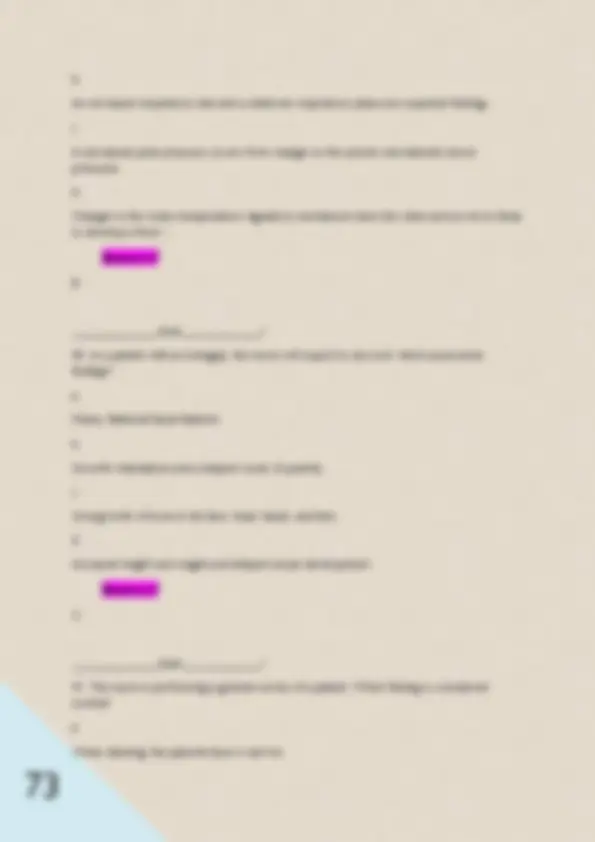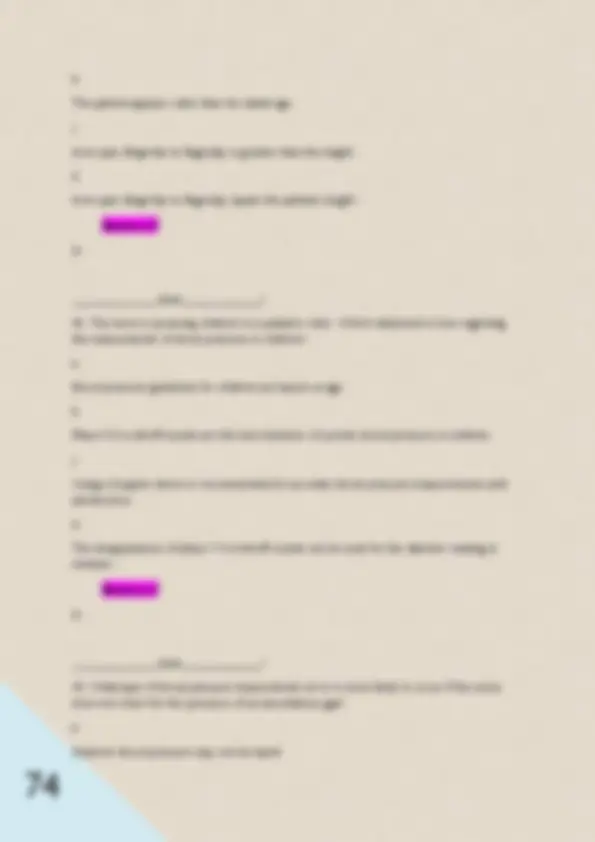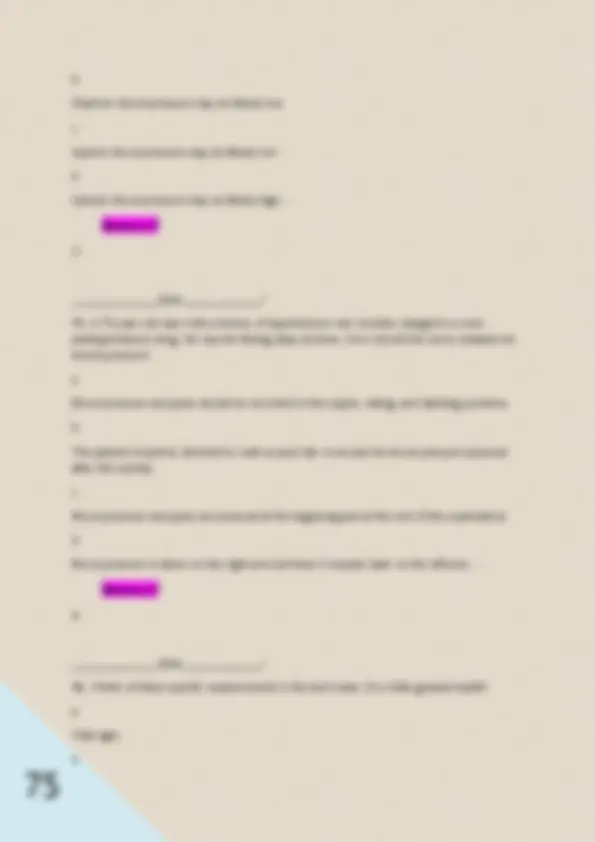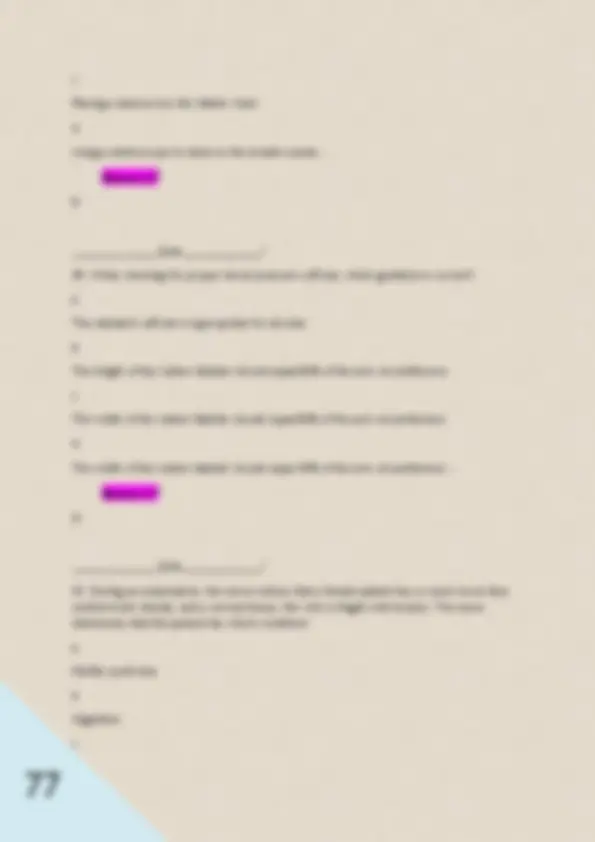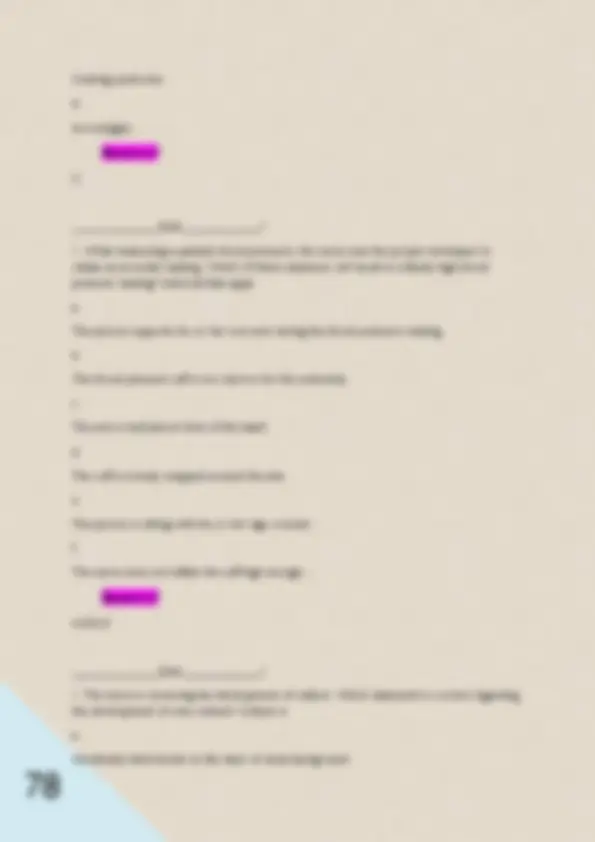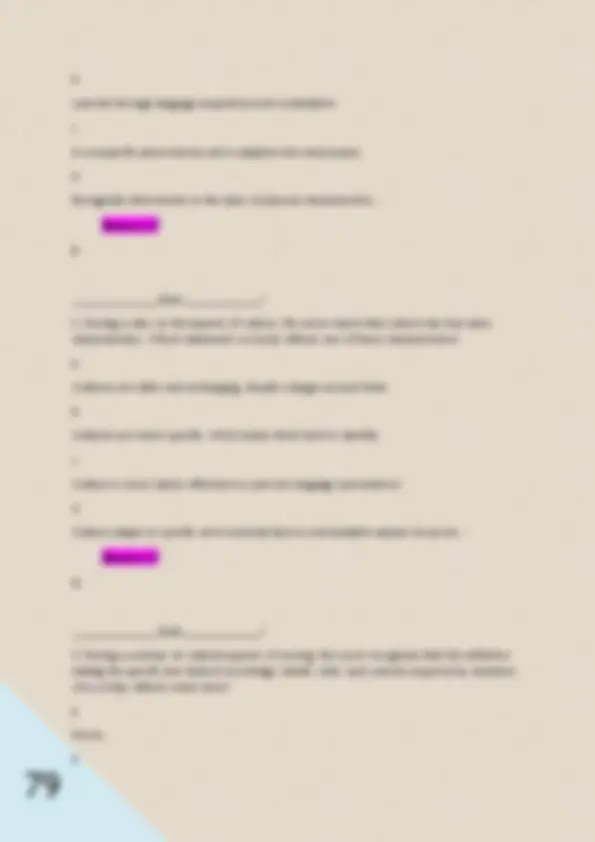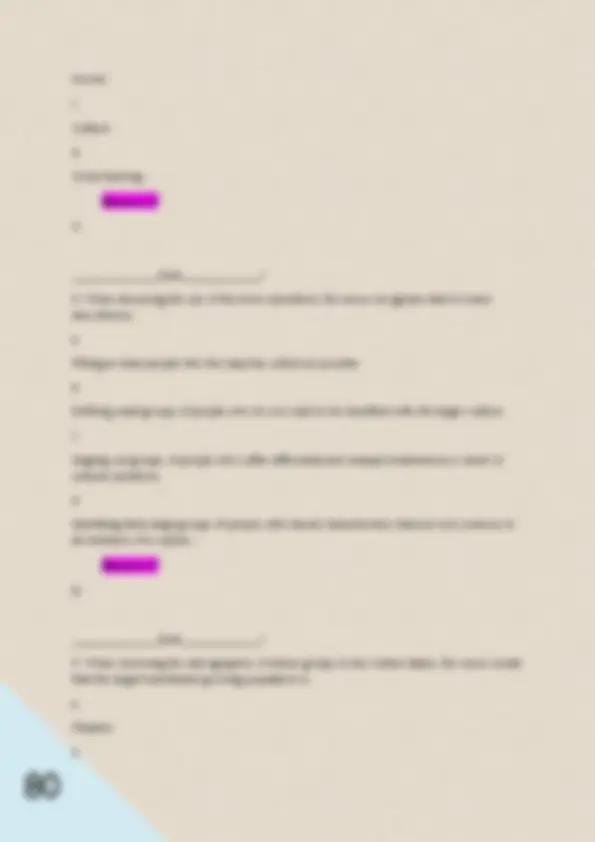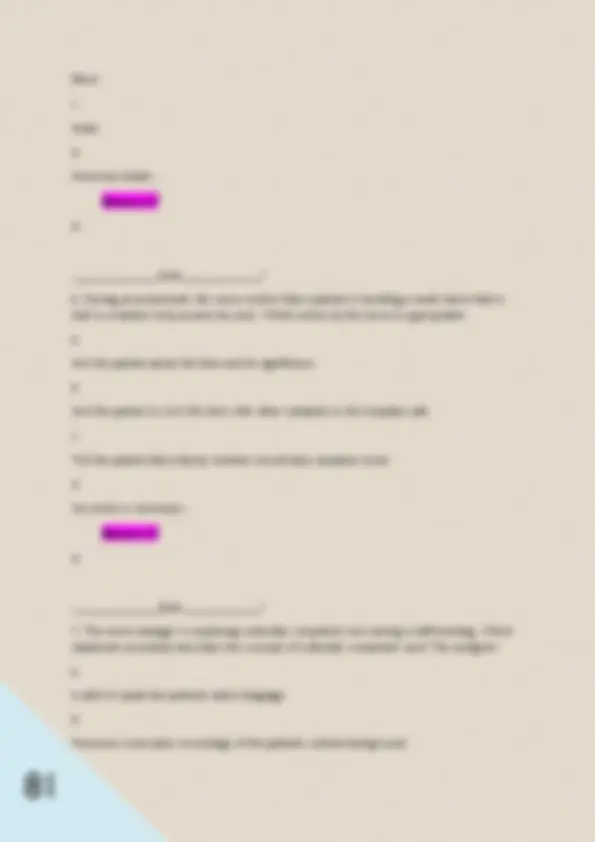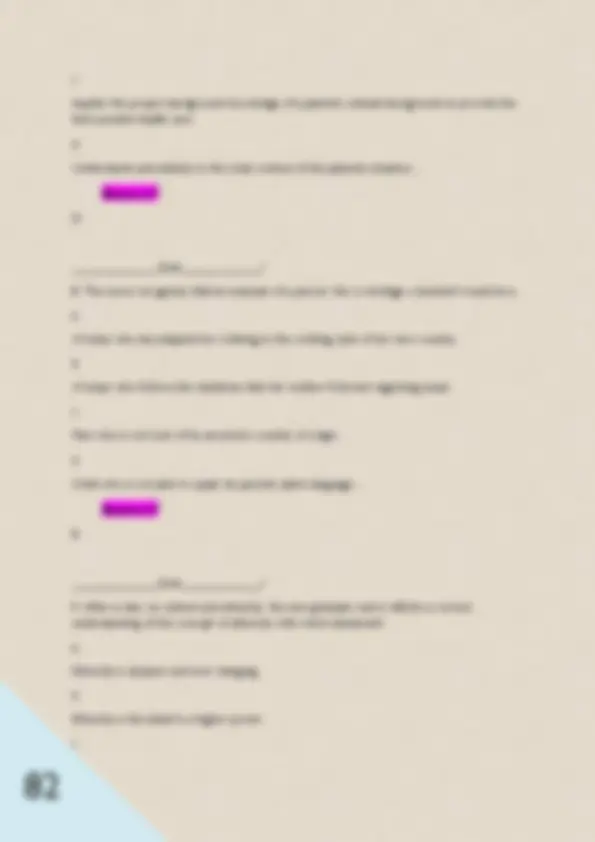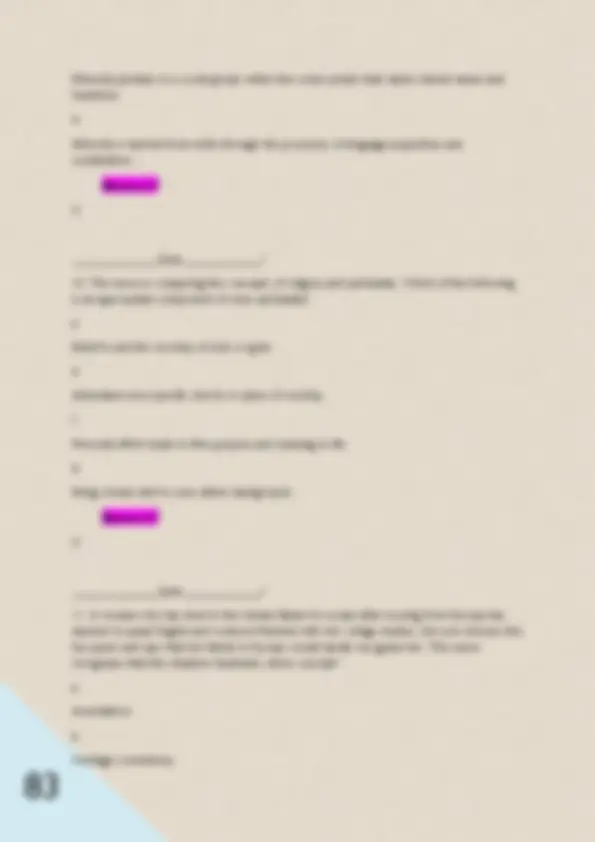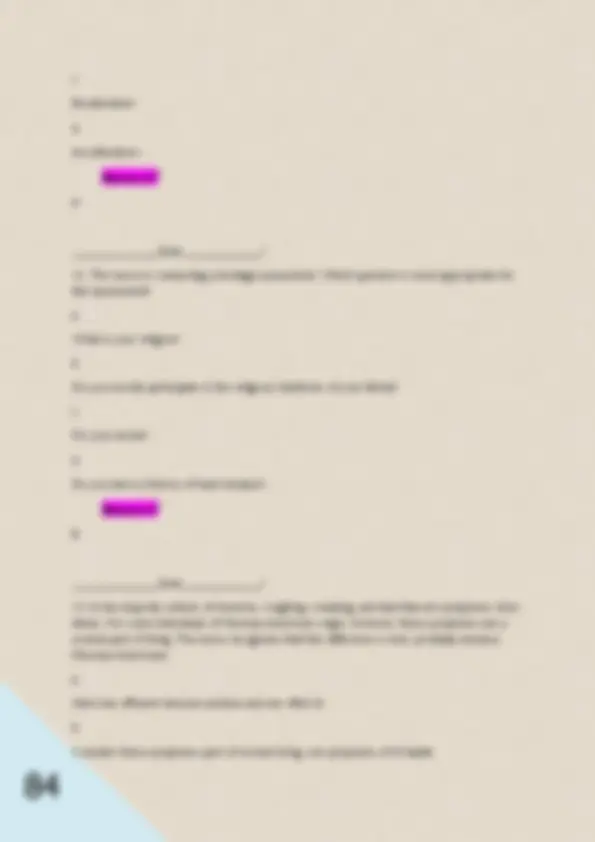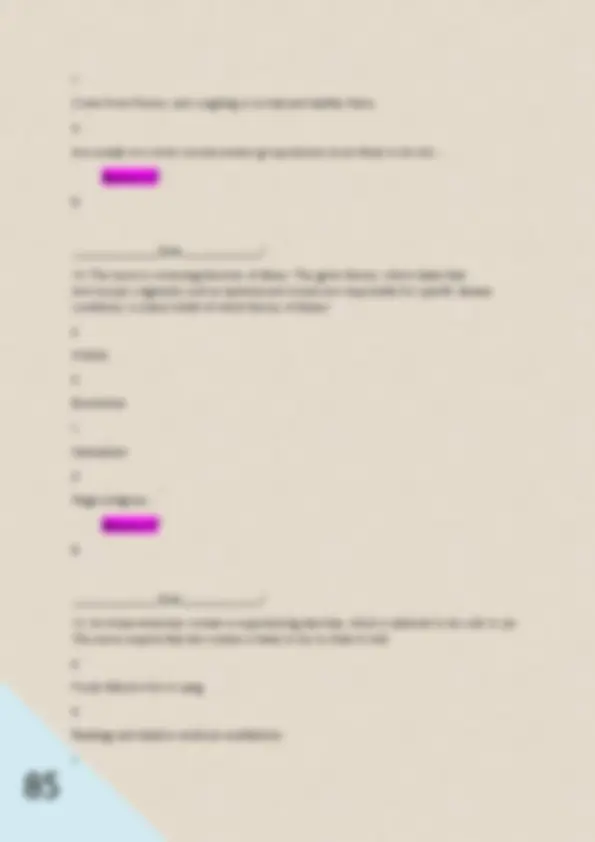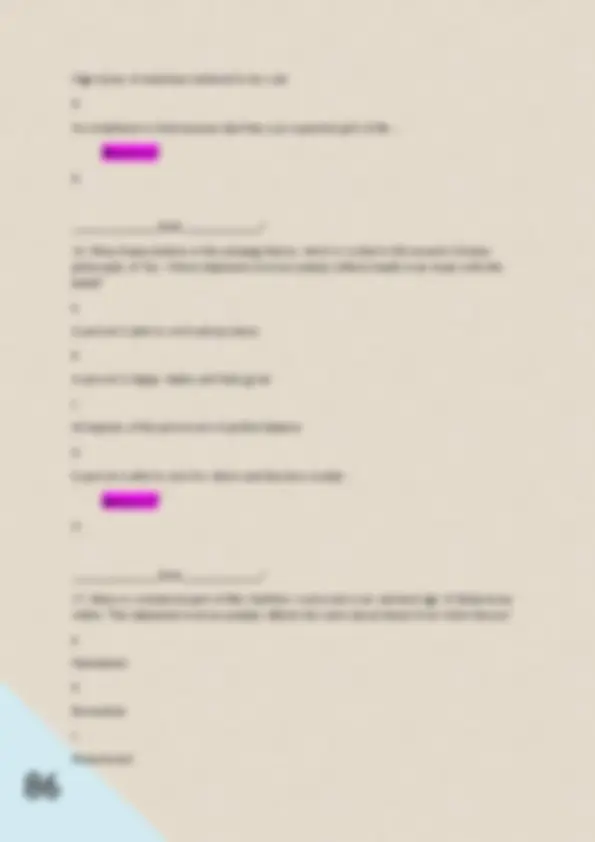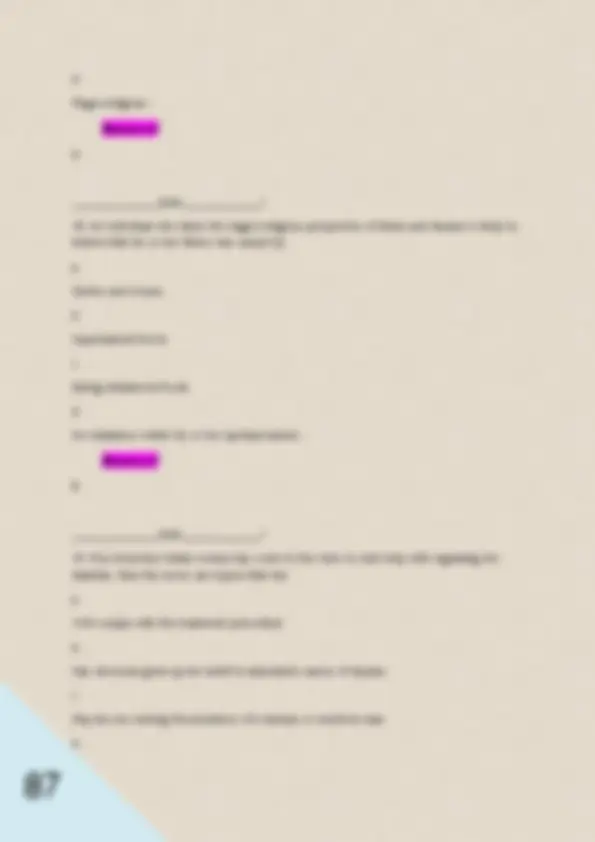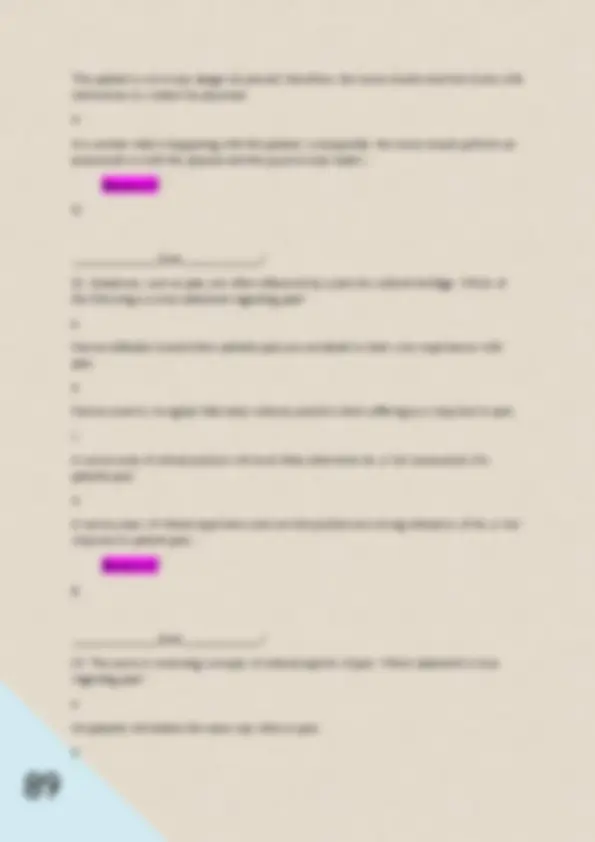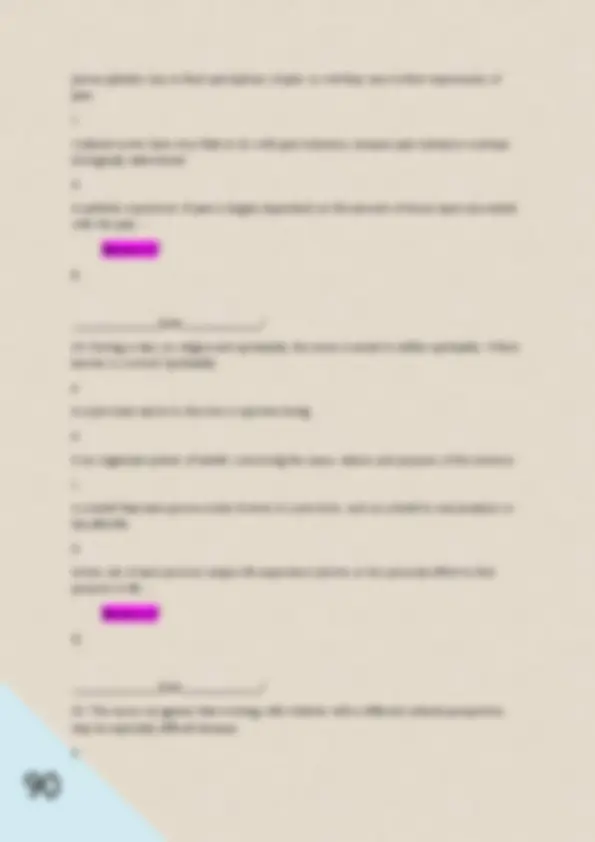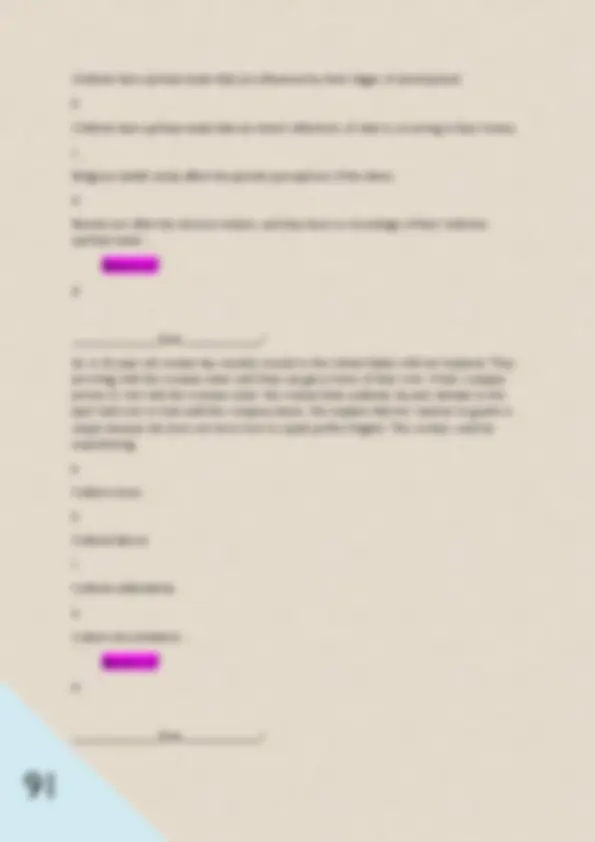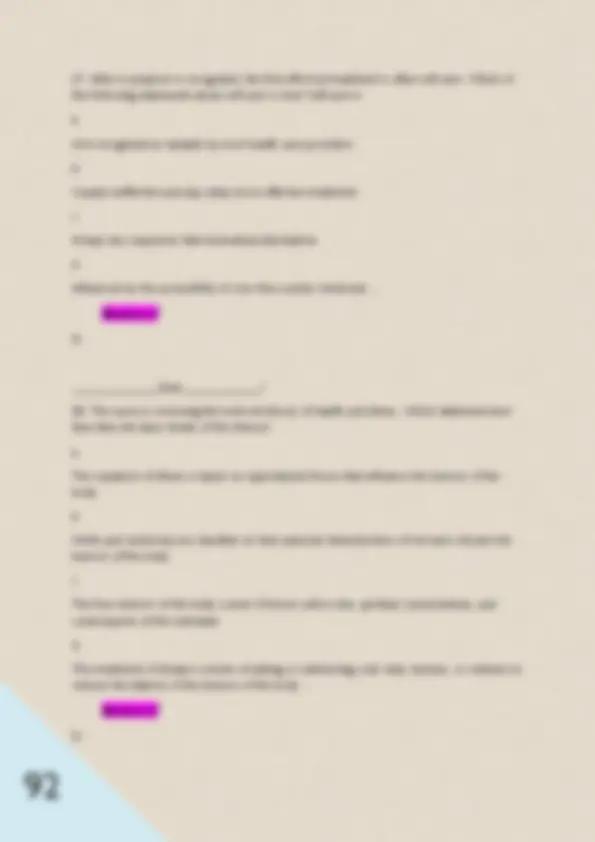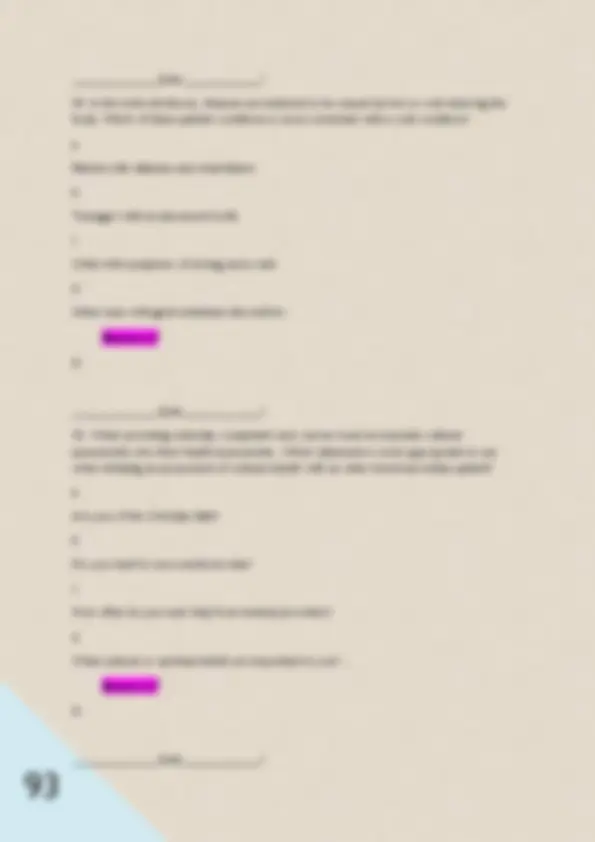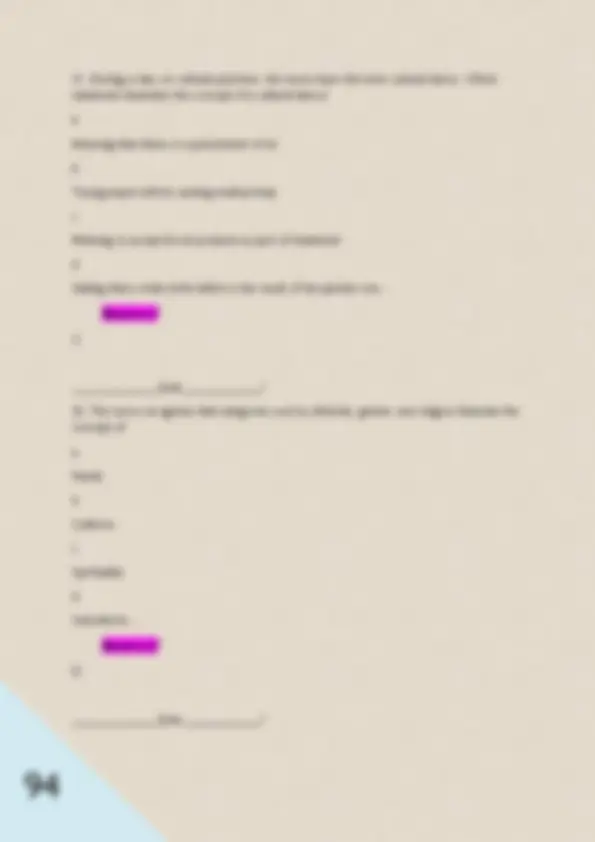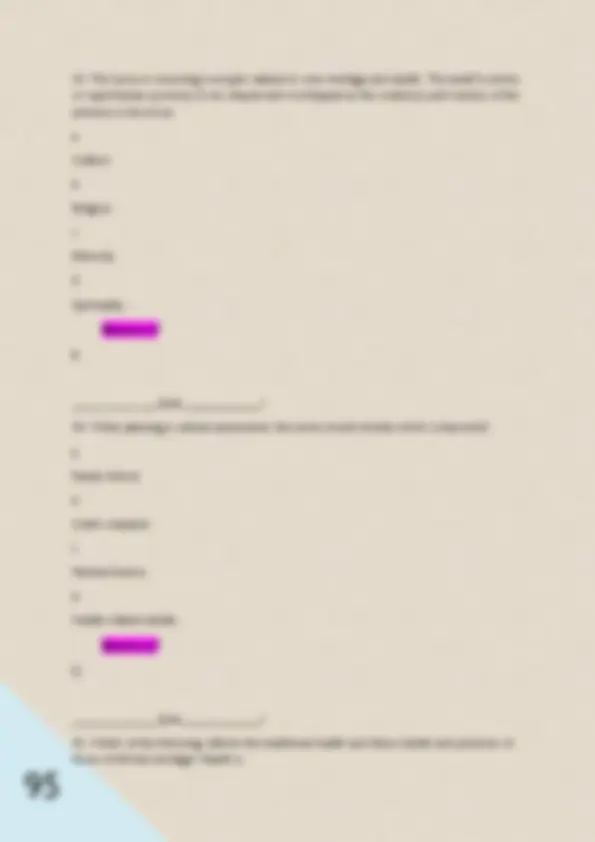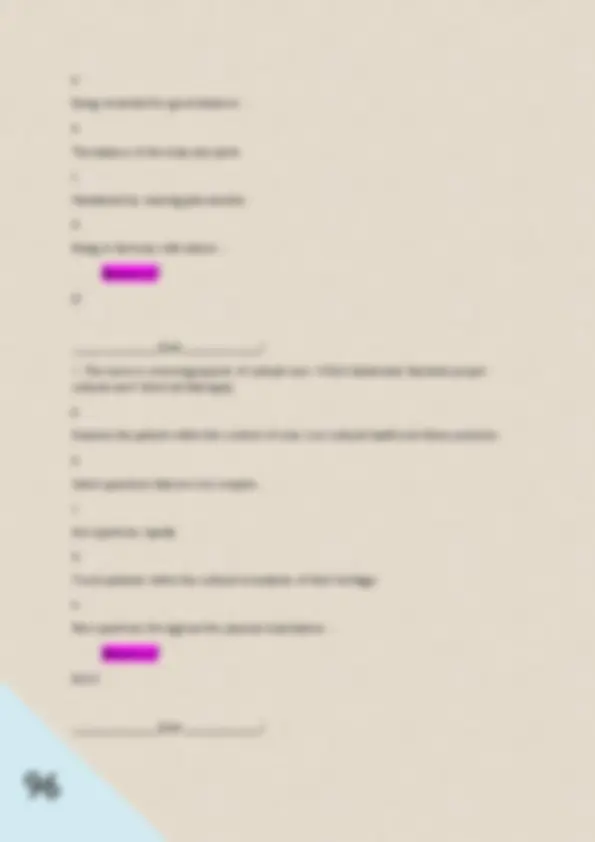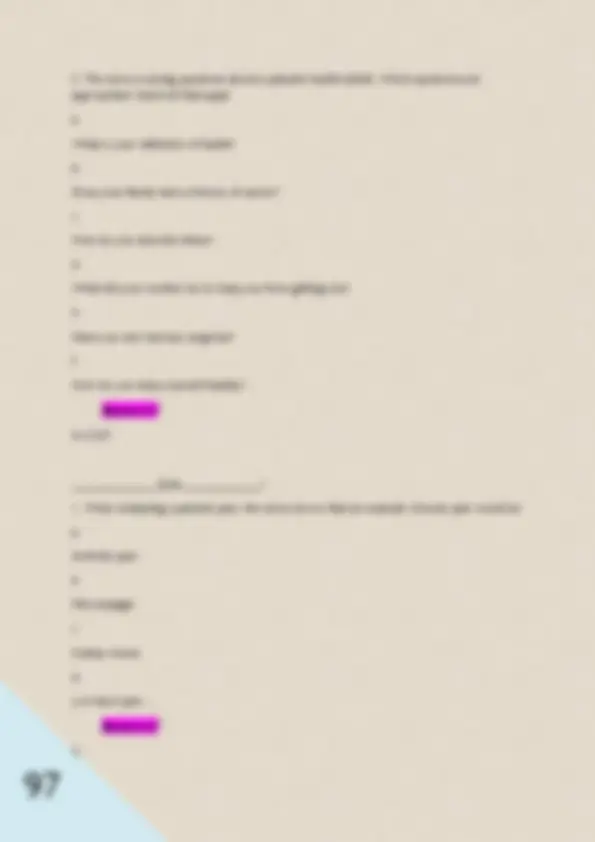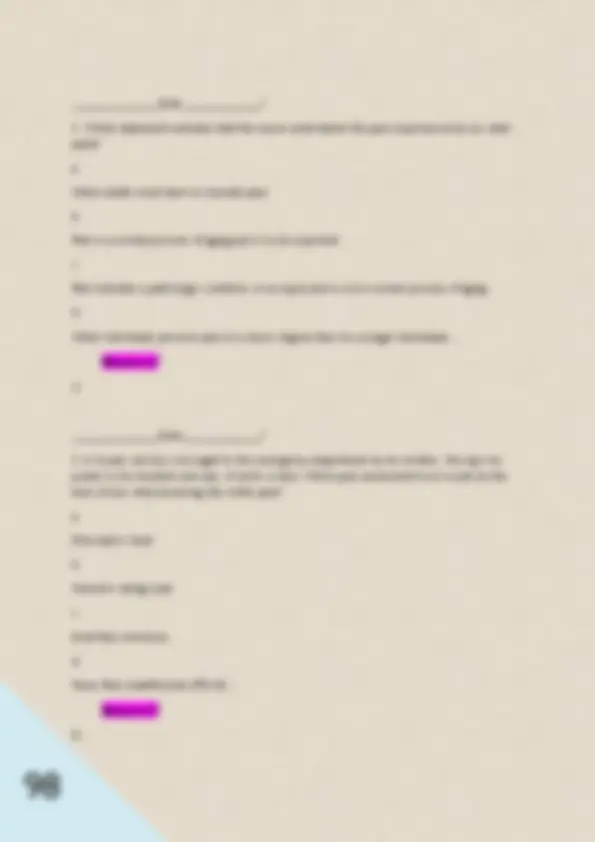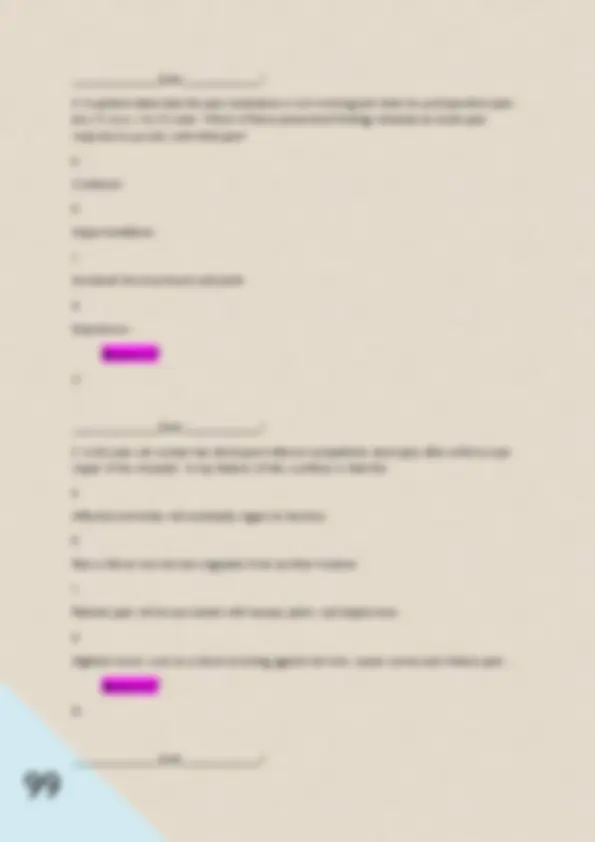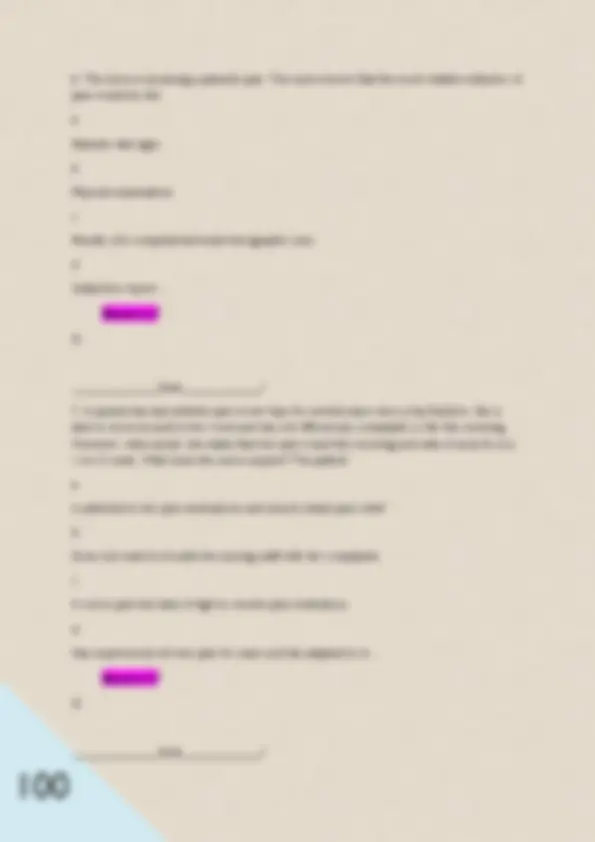Download NUR 210 EXAM 1 Test Bank / Questions & Expertly Verified Answers, 2025 / 2026. __________ and more Exams Nursing in PDF only on Docsity!
_____________Quiz____________? After completing an initial assessment of a patient, the nurse has charted that his respirations are eupneic and his pulse is 58 beats per minute. These types of data would be: a. Objective. b. Reflective. c. Subjective. d. Introspective. -
Answer ✓✓
A
_____________Quiz____________?
- A patient tells the nurse that he is very nervous, is nauseated, and feels hot. These types of data would be: a. Objective. b. Reflective. c.
Subjective. d. Introspective. -
Answer ✓✓
C
_____________Quiz____________?
- The patients record, laboratory studies, objective data, and subjective data combine to form the: a. Data base. b. Admitting data. c. Financial statement. d. Discharge summary. -
Answer ✓✓
A
_____________Quiz____________?
- When listening to a patients breath sounds, the nurse is unsure of a sound that is heard. The nurses next action should be to: a. Immediately notify the patients physician. b. Document the sound exactly as it was heard. c. Validate the data by asking a coworker to listen to the breath sounds.
Diagnostic reasoning. -
Answer ✓✓
A
_____________Quiz____________?
- The nurse is reviewing information about evidence-based practice (EBP). Which statement best reflects EBP? a. EBP relies on tradition for support of best practices. b. EBP is simply the use of best practice techniques for the treatment of patients. c. EBP emphasizes the use of best evidence with the clinicians experience. d. The patients own preferences are not important with EBP. -
Answer ✓✓
C
_____________Quiz____________?
- The nurse is conducting a class on priority setting for a group of new graduate nurses. Which is an example of a first-level priority problem? a. Patient with postoperative pain b. Newly diagnosed patient with diabetes who needs diabetic teaching c. Individual with a small laceration on the sole of the foot d. Individual with shortness of breath and respiratory distress -
Answer ✓✓
D
_____________Quiz____________?
- When considering priority setting of problems, the nurse keeps in mind that second-level priority problems include which of these aspects? a. Low self-esteem b. Lack of knowledge c. Abnormal laboratory values d. Severely abnormal vital signs -
Answer ✓✓
C
_____________Quiz____________?
- Which critical thinking skill helps the nurse see relationships among the data? a. Validation b. Clustering related cues c. Identifying gaps in data d. Distinguishing relevant from irrelevant -
Answer ✓✓
B
_____________Quiz____________?
- A newly admitted patient is in acute pain, has not been sleeping well lately, and is having difficulty breathing. How should the nurse prioritize these problems? a. Breathing, pain, and sleep b. Breathing, sleep, and pain c. Sleep, breathing, and pain d. Sleep, pain, and breathing -
Answer ✓✓
A
_____________Quiz____________?
- Which of these would be formulated by a nurse using diagnostic reasoning? a. Nursing diagnosis b. Medical diagnosis c. Diagnostic hypothesis d. Diagnostic assessment -
Answer ✓✓
C
_____________Quiz____________?
- Barriers to incorporating EBP include:
a. Nurses lack of research skills in evaluating the quality of research studies. b. Lack of significant research studies. c. Insufficient clinical skills of nurses. d. Inadequate physical assessment skills. -
Answer ✓✓
A
_____________Quiz____________?
- What step of the nursing process includes data collection by health history, physical examination, and interview? a. Planning b. Diagnosis c. Evaluation d. Assessment -
Answer ✓✓
D
_____________Quiz____________?
- During a staff meeting, nurses discuss the problems with accessing research studies to incorporate evidence-based clinical decision making into their practice. Which suggestion by the nurse manager would best help these problems? a.
b. The majority of deaths among Americans under age 65 years are not preventable. c. Prevention places the emphasis on the link between health and personal behavior. d. The means to prevention is through treatment provided by primary health care practitioners. -
Answer ✓✓
C
_____________Quiz____________?
- The nurse is performing a physical assessment on a newly admitted patient. An example of objective information obtained during the physical assessment includes the: a. Patients history of allergies. b. Patients use of medications at home. c. Last menstrual period 1 month ago. d. 2 5 cm scar on the right lower forearm. -
Answer ✓✓
D
_____________Quiz____________?
- A visiting nurse is making an initial home visit for a patient who has many chronic medical problems. Which type of data base is most appropriate to collect in this setting? a. A follow-up data base to evaluate changes at appropriate intervals b.
An episodic data base because of the continuing, complex medical problems of this patient c. A complete health data base because of the nurses primary responsibility for monitoring the patients health d. An emergency data base because of the need to collect information and make accurate diagnoses rapidly -
Answer ✓✓
C
_____________Quiz____________?
- Which situation is most appropriate during which the nurse performs a focused or problem-centered history? a. Patient is admitted to a long-term care facility. b. Patient has a sudden and severe shortness of breath. c. Patient is admitted to the hospital for surgery the following day. d. Patient in an outpatient clinic has cold and influenza-like symptoms. -
Answer ✓✓
D
_____________Quiz____________?
- A patient is at the clinic to have her blood pressure checked. She has been coming to the clinic weekly since she changed medications 2 months ago. The nurse should: a. Collect a follow-up data base and then check her blood pressure. b.
- A 42-year-old patient of Asian descent is being seen at the clinic for an initial examination. The nurse knows that including cultural information in his health assessment is important to: a. Identify the cause of his illness. b. Make accurate disease diagnoses. c. Provide cultural health rights for the individual. d. Provide culturally sensitive and appropriate care. -
Answer ✓✓
D
_____________Quiz____________?
- In the health promotion model, the focus of the health professional includes: a. Changing the patients perceptions of disease. b. Identifying biomedical model interventions. c. Identifying negative health acts of the consumer. d. Helping the consumer choose a healthier lifestyle. -
Answer ✓✓
D
_____________Quiz____________?
- The nurse has implemented several planned interventions to address the nursing diagnosis of acute pain. Which would be the next appropriate action?
a. Establish priorities. b. Identify expected outcomes. c. Evaluate the individuals condition, and compare actual outcomes with expected outcomes. d. Interpret data, and then identify clusters of cues and make inferences. -
Answer ✓✓
C
_____________Quiz____________?
- Which statement best describes a proficient nurse? A proficient nurse is one who: a. Has little experience with a specified population and uses rules to guide performance. b. Has an intuitive grasp of a clinical situation and quickly identifies the accurate solution. c. Sees actions in the context of daily plans for patients. d. Understands a patient situation as a whole rather than a list of tasks and recognizes the long-term goals for the patient. -
Answer ✓✓
D
_____________Quiz____________?
- The nurse is reviewing data collected after an assessment. Of the data listed below, which would be considered related cues that would be clustered together during data analysis? Select all that apply. a.
that she and her husband are excited about the pregnancy but have a few questions. She looks nervously at her hands during the interview and sighs loudly. Considering the concept of communication, which statement does the nurse know to be most accurate? The woman is: a. Excited about her pregnancy but nervous about the labor. b. Exhibiting verbal and nonverbal behaviors that do not match. c. Excited about her pregnancy, but her husband is not and this is upsetting to her. d. Not excited about her pregnancy but believes the nurse will negatively respond to her if she states this. -
Answer ✓✓
B
_____________Quiz____________?
- Receiving is a part of the communication process. Which receiver is most likely to misinterpret a message sent by a health care professional? a. Well-adjusted adolescent who came in for a sports physical b. Recovering alcoholic who came in for a basic physical examination c. Man whose wife has just been diagnosed with lung cancer d. Man with a hearing impairment who uses sign language to communicate and who has an interpreter with him -
Answer ✓✓
C
_____________Quiz____________?
- The nurse makes which adjustment in the physical environment to promote the success of an interview? a. Reduces noise by turning off televisions and radios b. Reduces the distance between the interviewer and the patient to 2 feet or less c. Provides a dim light that makes the room cozy and helps the patient relax d. Arranges seating across a desk or table to allow the patient some personal space -
Answer ✓✓
A
_____________Quiz____________?
- In an interview, the nurse may find it necessary to take notes to aid his or her memory later. Which statement is true regarding note-taking? a. Note-taking may impede the nurses observation of the patients nonverbal behaviors. b. Note-taking allows the patient to continue at his or her own pace as the nurse records what is said. c. Note-taking allows the nurse to shift attention away from the patient, resulting in an increased comfort level. d. Note-taking allows the nurse to break eye contact with the patient, which may increase his or her level of comfort. -
Answer ✓✓
A
_____________Quiz____________?
- During an interview, the nurse states, You mentioned having shortness of breath. Tell me more about that. Which verbal skill is used with this statement? a. Reflection b. Facilitation c. Direct question d. Open-ended question -
Answer ✓✓
D
_____________Quiz____________?
- A patient has finished giving the nurse information about the reason he is seeking care. When reviewing the data, the nurse finds that some information about past hospitalizations is missing. At this point, which statement by the nurse would be most appropriate to gather these data? a. Mr. Y., at your age, surely you have been hospitalized before! b. Mr. Y., I just need permission to get your medical records from County Medical. c. Mr. Y., you mentioned that you have been hospitalized on several occasions. Would you tell me more about that? d. Mr. Y., I just need to get some additional information about your past hospitalizations. When was the last time you were admitted for chest pain? -
Answer ✓✓
D
_____________Quiz____________?
- In using verbal responses to assist the patients narrative, some responses focus on the patients frame of reference and some focus on the health care providers perspective. An example of a verbal response that focuses on the health care providers perspective would be: a. Empathy. b. Reflection. c. Facilitation. d. Confrontation. -
Answer ✓✓
D
_____________Quiz____________?
- When taking a history from a newly admitted patient, the nurse notices that he often pauses and expectantly looks at the nurse. What would be the nurses best response to this behavior? a. Be silent, and allow him to continue when he is ready. b. Smile at him and say, Dont worry about all of this. Im sure we can find out why youre having these pains. c. Lean back in the chair and ask, You are looking at me kind of funny; there isnt anything wrong, is there? d.

